
TABLE OF CONTENTS
Ye Ed’s Rant: On Gerber, Skrenes, TwoMorrows’ doings at this year’s SDCC, and more! 2
COMICS CHATTER
Stan’s Excelsior Comics: Ye Ed, with the help of brother editor Roy Thomas, uncovers the secret history of Stan Lee’s own comics imprint developed in the mid-’90s............. 3

Incoming: One reader wishes we talked to Don McGregor about his Spider-Man tale 14
Cooke’s Column: Chatting about Philip Bentley, Tim Hensley, and pal Denis Kitchen 15
Hembeck’s Dateline: Fred’s “Perfect Day” in 1964, with Vic, Boris, and Richie 17
Ten Questions: Darrick Patrick chills out with writer Jonathan Chance 18
Comics in the Library: Richard Arndt on books that took long journeys to the shelf ..... 20
Once Upon Long Ago: Steve Thompson goes underground and digs the comix! .......... 21
Son of the Flame: Part two of Greg Biga’s profile of artist Mike Deodato, Jr., where we learn, with insights from Tom Brevoort and Rain Beredo, of the artist’s fall and rise .... 22
THE MAIN EVENTS
Steve Gerber and the Kindness of Strangers
Presenting a transcript of a wonderful and informative radio interview with the revolutionary comic-book scribe conducted in early 1994 on the New York City WBAI “Nuff Said” talk show, hosted by Ken Gale and Ed Menja. Featuring some wacky call-in listeners, it spotlights the innovative writer in peak form and at his candid best ......... 30
Mary Skrenes: Dark Figure of Mystery (and Friend of Ol’ Gerber!)
CBC’s awesomely entertaining and lengthy interview with the 1970s comics writer, who collaborated with her pal Steve Gerber on Howard the Duck and creating Omega the Unknown with the Gerbs! From growing up in Las Vegas to the wild ’70s Bullpen scene to doing Hard Time with Gerber, this is Mary’s first comprehensive Q-&-A ever! 46
Straight Outta Cleveland: Chrissie Hynde’s “Precious” and a certain Howard T. Duck .. 70
Val Mayerik and His Fowl Connection: The artist talks about his life and that bird .... 73
BACK MATTER
Creators at the Con: Kendall Whitehouse clix comics peeps showing off their stuff 78
Coming Attractions: Dan Jurgens on the death and life (of Superman) and more! 79


A Picture Is Worth A Thousand Words: Tom Ziuko shares a Geo. Pérez masterwork! 80
EDITOR’S NOTE: Note that some images in this issue have been enhanced with software. Right: Detail of Howard the Duck from a 1978 Marvel Comics house ad, drawn by Gene Colan and Klaus Janson.
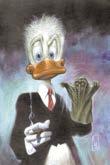
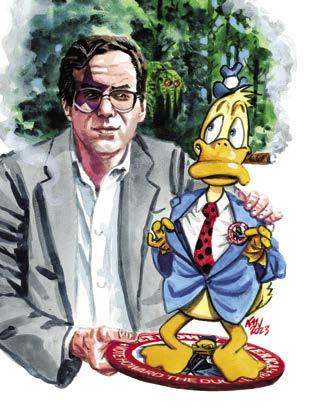
Comic Book Artist Vol. 1 & 2 are available as digital downloads from twomorrows.com


Comic Book Creator ™ is published quarterly by TwoMorrows Publishing, 10407 Bedfordtown Dr., Raleigh, NC 27614 USA. Phone: (919) 449-0344. Jon B. Cooke, editor. John Morrow, publisher. Comic Book Creator editorial offices: P.O. Box 601, West Kingston, RI 02892 USA. E-mail: jonbcooke@aol.com. Send subscription funds to TwoMorrows, NOT to the editorial offices. Four-issue subscriptions: $53 US, $78 International, $19 Digital. All characters are © their respective copyright owners. All material © their creators unless otherwise noted. All editorial matter ©2024 Jon B. Cooke/ TwoMorrows. Comic Book Creator is a TM of Jon B. Cooke/TwoMorrows. ISSN 2330-2437. Printed in China. FIRST PRINTING. Above: Our cover is actually based on a commissioned painting by Val Mayerik that we found on the internet. When the artist said he had no scan of the piece, he agreed to draw us a replica, this one featuring Omega the Unknown as a puppet in reference to the Mary Skrenes interview herein. Many thanks to Val for producing the cover illustration for this, our Stephen Ross Gerber special ish! Winter 2024 • The Steve Gerber Issue • Number 33 STEVE GERBER Portrait by KEN MEYER, JR. ©2024 Ken Meyer, Jr. Howard the Duck, Man-Thing, Omega TM & © Marvel Characters,
TM & © Marvel Characters, Inc.
Our
Inc.
About
Cover
Cover art and colors by VAL MAYERIK
COMIC BOOK CREATOR is a proud joint production of Jon B. Cooke/TwoMorrows
C’mon citizen, DO THE RIGHT THING! A Mom & Pop publisher like us needs every sale just to survive! DON’T DOWNLOAD OR READ ILLEGAL COPIES ONLINE! Buy affordable, legal downloads only at www.twomorrows.com or through our Apple and Google Apps! & DON’T SHARE THEM WITH FRIENDS OR POST THEM ONLINE. Help us keep producing great publications like this one! Don’t STEAL our Digital Editions!
Stan’s Excelsior Comics
The inside story of the ill-fated mid-1990s comic book line created by Stan “The Man” Lee
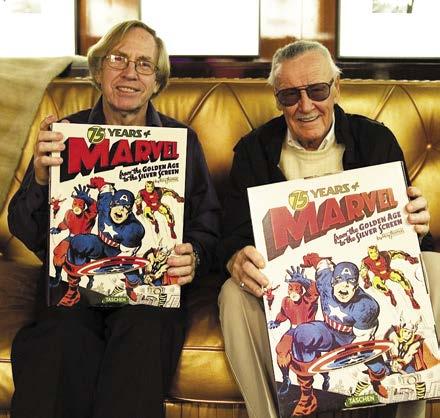 by JON B. COOKE
by JON B. COOKE
There in the twilight cold and gray, Lifeless, but beautiful, he lay, And from the sky, serene and far, A voice fell like a falling star, Excelsior!
—
“Excelsior” [1841], Henry Wadsworth Longfellow
The Man, he was obviously excited about it, enough so to trumpet the new line’s apparent impending arrival in the annual of note among his fellow newspaper comic strip professionals. There it was, on page 166 of The National Cartoonists Society Album of 1996: an announcement to make envious his peers regarding his own line of comic magazines: “After two decades, Stan is still writing the Spider-Man newspaper strip,” it read, “and is about to launch Excelsior Comics, his own imprint for Marvel.”
Stan, of course, was Stan “The Man” Lee, fabled impresario of Marvel Comics, and that new brand — named for Lee’s signature phrase, which was probably derived from Longfellow’s samenamed poem* (the final stanza quoted above) — was a small but ambitious imprint that, during Marvel’s tumultuous 1990s, would be fully developed yet, alas, never live to see the light of day.
meant ‘upward and onward’; I liked that it was kind of an obscure word, and I don’t think the competitors were smart enough or verbose enough to get it and copy it. And I was right. It really caught on and became kind of a signature phrase for myself and for Marvel Comics. And now we actually have a comics line called Excelsior Comics.”
By the time Sean Leary’s Q-&-A saw print on Dec. 24, 1995, Lee had become ever more frustrated with the production of the four titles that comprised the Excelsior line. “Stan had wanted to get the new books out for a while now,” Ronin Ro related in Tales to Astonish: Jack Kirby, Stan Lee, and the American Comic Book Revolution [2004], “but Marvel was trying to license the characters to a company that made video games. Until that deal was signed, nothing would happen. The delay was getting to him — he’d been developing Excelsior Comics for a year now — but Marvel executives said he simply had to wait until the right time.”
BACK TO BASICS?
A few months before a fateful final decision was made back in the Marvel Entertainment Group corporate offices, Lee expressed his dismay over violence in comics of that era. “When you talk about how much darker, or rougher things have gotten,” he told a Pittsburgh Post-Gazette feature writer, “I’m not happy with it, because the whole world has gotten darker and, along with it, movies, television, and your family newspaper.” He continued, “I will admit that, in today’s comics, there doesn’t seem to be as many different emotions. It’s all angst and anger. Eventually, my guess is, the public will get tired of this one-note treatment by every comic-book company, though I think Marvel is less guilty of it than others.”
When asked by the Rock Island Argus entertainment editor about the origin of his one-word sign-off, Lee explained, “I love using unique expressions and I was always trying to come up with ones that are new and distinctive. I started using ‘nuff said,’ but then I noticed the competition began doing the same thing. So then I switched to ‘Face front!’ and a few others, and they kept copying them. So finally I wanted to come up with something they couldn’t figure out or copy, and I came up with ‘excelsior.’ Everything about it seemed to work. I liked the sound of it; I liked that it
*According to my copy of The Compact Edition of the Oxford English Dictionary [1971], the word had a dubious origin: “The adverbial meaning (= ‘upwards’) commonly given to the motto cannot be justified by Latin grammar. According to [Longfellow’s biography], the poet was at first unaware of the solecism [misusage] in the motto as thus interpreted, and, when it was pointed out to him, suggested the words might be taken to stand for Scopus meus excelsior ets, ‘My goal is higher.’” Referring to it being established in 1778 as the motto on the seal of the State of New York, the dictionary shared, “It is not clear whether the original use on the seal is a blunder, or whether it was meant as an abbreviation for some grammatically admissible phrase.”
The newspaper revealed, citing his co-creators of an earlier decade, “Lee hopes to recover a bit of the magic he, Kirby, and Ditko had in the ’60s with his own Excelsior Comics line, slated to debut in ’96. The imprint will be distributed by Marvel.”
But any impression that the books would be unlike the darker, rougher Image Comics and some return to the wholesome, G-rated milieu of Jolly Jack, Sturdy Steve,and Smilin’ Stan would be wrong, said Kurt Busiek, who contributed to the Excelsior line. “No, I got exactly the opposite impression. If I remember correctly, all the series premises had some sort of dark, gritty, edgy aspect to them, like Stan was very much trying to play to a modern audience.”
Above: The logo for Stan Lee’s Excelsior comics line, intended to be a sub-imprint of Marvel, which was developed between 1994–96, but was deep-sixed by unknown parties despite much work being completed on the four titles. Inset left: Lee’s bio blurb from the 1996 National Cartoonist Society Album. Below: Roy Thomas (left) and Lee smile for the camera while displaying the massive Taschen-published tome, 75 Years of Marvel [2014].
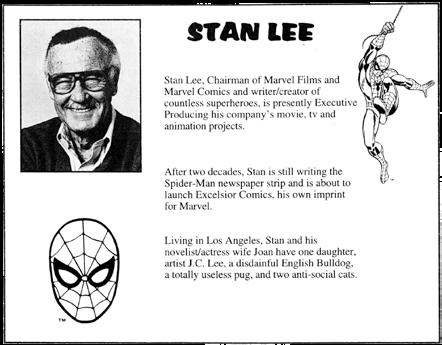
This issue is dedicated to the memories of JON BERK, up front
All characters TM & © Marvel Characters, Inc. Excelsior! TM POW! Entertainment, LLC. COMIC BOOK CREATOR • Winter 2024 • #33 3
This page: When the 1990s arrived, the notion of Marvel publisher Stan Lee having his own sub-imprint at the House of Ideas was gestating. Though the initial foray, Marvel World of Tomorrow, was when the line’s de facto creative director John Byrne quit, the concepts would develop to become Marvel’s 2099 line of books set in the future. Of the four initial titles, Lee would write seven issues of Ravage 2099, a wholly original character he created.
Above is Marvel Age #117 [Oct. 1992] promoting 2099 (art by Paul Ryan), and below are early designs for the debut characters..
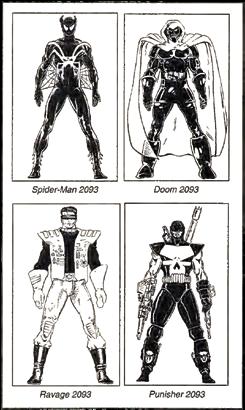
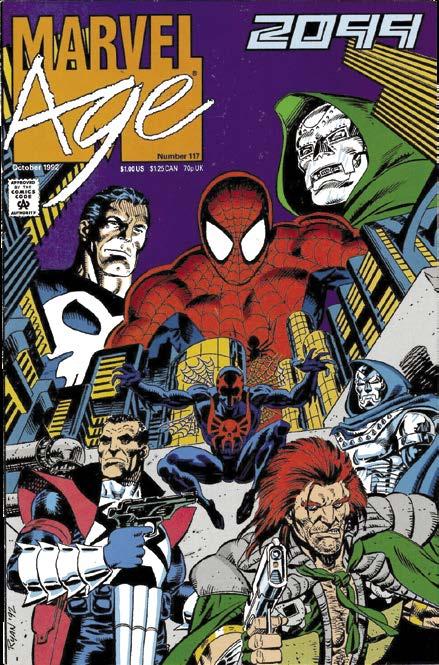
Busiek, who only recently had successfully melded the retro with the modern, as writer of Alex Ross and his smash hit mini-series, Marvels,* thought Lee’s target was off. “His sense of the audience was about ten years behind the times. I think I said to someone at the time that the Excelsior books were going to feel like throwbacks, but like ’80s throwbacks rather than ’60s throwbacks.”
DAYS OF BOOM AND BUST
In terms of the business, the 1990s was among the most volatile decades in the history of the American comic book. There were highs: in 1991, Jim Lee and Chris Claremont’s X-Men #1 became the best-selling comic book of all time, with 8.1 million copies sold and, the year following, DC shipped over six million copies of Superman #75, the “death” of the character. Plus, dynamic new publishers stepped into the field, including Image and Valiant. Also Tundra, Topps, Vertigo, and Dark Horse were making critical impacts.
And there were, of course, the lows: the truth being that behind those mentioned record-breaking sales were speculators, many from outside comics fandom — one estimate had Nov. 17, 1992, the day the “Death of Superman” arrived in stores, generating $30 million for the comics industry — investors who just as quickly vanished from the stores as they realized the boom was unsustainable. Chuck Rozanski, head of Mile High Comics, memorized a specific day he recognized when boom had turned to bust: “I can even give you a date: it’s April 23, 1993,” he told George Khoury, in Image Comics: The Road to Independence [2007]. “That was the day that ‘Superman Returns’ shipped… these books were the kiss of death.” It is believed upwards of 1,000 direct sales comic shops closed in the first quarter of 1994.
Despite all of this pandemonium — and probably fueled by the phenomenal success of Image Comics, the creator-owned line run by fan-favorite super-star artists which launched in 1992 — Stan Lee had received the go-ahead in the second quarter of ’94 to develop his own comic book line (to be owned by Marvel). After all, why shouldn’t the number one celebrity comic creator, the most famous of them all, have his own line of books? Even with the able participation of a squad of veteran comic book writers from start to its abrupt finish, a team which consisted of his personal pick back in 1972 to replace his own self as Marvel editor-in-chief, as well as Marvel’s then recently-departed E-I-C, and a white-hot fan-favorite writer of the day, it proved to be a remarkably long process.
*Busiek told this writer, “After Marvels came out, Stan called me at home to tell me he thought I was a genius. It was a very flattering call, although it took me a minute or so to shake the idea that this was simply a prank being pulled by someone who did the best Stan impression I’d ever heard. But I think Stan must have really liked it — he didn’t have to call, after all.” The award-winning scribe didn’t like the word, “retro,” used to characterize his series, which told the ’60s “Marvel saga” as seen through the eyes of average folk. “We were telling a story involving older Marvel continuity, but we weren’t doing it in a way that re-created the style of those old books, either in writing or art. Our approach was pretty modern, even if our source material was old.”
THE EXCELSIORVERSE
The notion of Excelsior Comics looks to have first implemented in at least summer 1994, as a fax dated Sept. 19 of that year was transmitted by aforementioned Lee E-I-C successor Roy Thomas.**
“First of all,” Thomas wrote to Lee and Excelsior senior editor, Rob Tokar, who had been hired in August, “Congratulations again, Stan, on finally getting a chance to do what I was always hoping you’d do while I lived in Los Angeles, namely, get a ‘Marvel West’ branch going. And congratulations to Rob on becoming the other half of its immediate editorial staff. I know you’ll do well.”
Thomas had resided in L.A. between mid-1976 and late ’91, having arrived nearly four years before Lee settled in Beverly Hills, and, in fact, he had been urging Lee to launch an imprint during their semi-frequent talks in the City of Angels throughout the ’80s. “Before Excelsior got started,” Thomas told Jim Amash, “I’d spent more than a decade urging Stan to start up his own comics line as a separate Marvel West Coast imprint! Back in the ’80s, when I wasn’t working for Marvel, but he and I both lived in L.A., I’d bring it up when we talked on the phone or had lunch.”
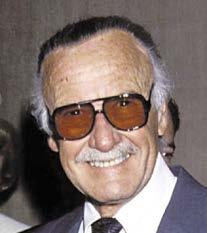
As Thomas had moved to South Carolina in ’91 with his wife, Dann, to create their veritable menagerie on a 40-acre spread — Thomas describes it today as “40 acres and a pool”! — he was a little perturbed, as he shared with Amash, “I actually felt a bit frustrated that finally, in 1994, he decides to do a line of comics — years after I’ve moved to South Carolina!” Thomas then mused, with a chuckle, “Maybe he was trying to tell me something.”
The Excelsior line-up was to start modestly as a quartet of titles, each featuring interconnecting characters in a shared universe, with crossovers envisioned for the future — though with zero connection to the Marvel super-hero realm — and all created by Lee in his “Marvel West” office within the New World Building. The four titles were to be:
Omega: The character, originally named “Nimbus,” is described thusly by the Excelsior handbook: “He’s mean, he’s bitter, he’s angry, he’s disgruntled, and he’s Earth’s only hope for peace. Omega is a hard-boiled, excommunicated ‘angel.’” The longhaired, strapping fellow (and quite literally, too, as his character design has the dude clad in straps aplenty!) is decked out in “energy projection discs” and wields a “sword of fire.” Series tagline: “The Avenging Angel.” The writer and artist assigned to the series were Kurt Busiek and Scottish artist Rob McCallum.
Zarlok: “One-fifth of the interstellar strike team known as the Matrix, [he] is proud of his role as a fierce, unstoppable warrior. When he’s commanded to slaughter innocent Earthlings, he crashes the Matrix’s ship rather than participate in their dishonorable butchery.” [Excelsior handbook] First named “Kinja,” and then “Zodiax,” he’s another well-built fellow, though with two guises: one wearing a leather jacket, biker gloves, and headband; the other, armored, masked regalia. (In a twist, Stan has Zarlok become a comics writer as a way to warn humanity of alien invasion!) Series tagline: “Trapped on Planet Earth.” Assigned to Thomas and Sal Buscema (with inks by Tom Palmer).
Vandal: “Top agent and most skilled fighter” of Securicom, “the leading law-and-morality enforcement agency in the year 2057” [Excelsior handbook]. A cross between Arnold Schwarzenegger and Arthur “Fonzie” Fonzarelli, this luxuriantly maned and smarmy gent is “vain, pompous, thrill-seeking, and girl crazy.”
**Roy Thomas, who had long urged Ye Ed to include a feature article on Excelsior in CBC, provided this magazine with a wealth of items from his time as freelancer working on Lee’s aborted comic book line. Many thanks to my fellow TwoMorrows editor!
#33 • Winter 2024 • COMIC BOOK CREATOR Marvel Age , Marvel 2099 TM & © Marvel Characters, Inc. 4
Stan Lee
There’s Something About Don
Reader Ben Herman wishes CBC had discussed a Spider-Man two-parter with McGregor
[With the picked-up pace of CBC frequency, our mail bags seem to be generating some new LOCs. Keep ’em coming! — Ye Ed.]
Ben Herman
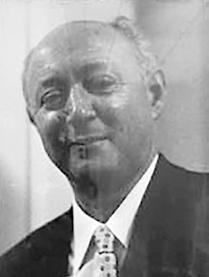
I found your interview with Don McGregor in Comic Book Creator #29 to be highly insightful. McGregor is one of those writers who people either seem to love or hate. I don’t think I’ve ever seen anyone who had an opinion of his work that was in-between those two extremes. Fortunately, I am one of those who has found his work to be highly thought-provoking.
It’s very clear that McGregor is exceedingly passionate about his work, about the characters and subjects of which he writes. I certainly agree with the assessment that he is one of the individuals who, in the 1970s and ’80s, played a vital role in the medium growing in more mature, sophisticated, intelligent directions.
Having been born in 1976 and gotten into comic books in the late 1980s, I discovered McGregor via the “Panther’s Quest” serial that ran in Marvel Comics Presents. Fortunately, since then, a great deal of his earlier work has been reprinted, enabling me to also read it.
My one regret about the interview is that McGregor did not discuss the Spider-Man [#27–28, Oct.–Nov. 1992] story, “There’s Something About a Gun,” he wrote that was published in 1992, with artwork by Marshall Rogers and Keith Williams, which addressed the plague of gun violence in American society. It is a story that, sadly, is even more relevant three decades later. I would have liked to have found out McGregor’s thoughts on how “There’s Something About a Gun” came about. In the past, he has alluded to the fact that he was dissatisfied with the published story due to disagreements with editorial. Having recently read the story again, I nevertheless feel it works extremely well, and that McGregor’s message did not appear at all diluted.
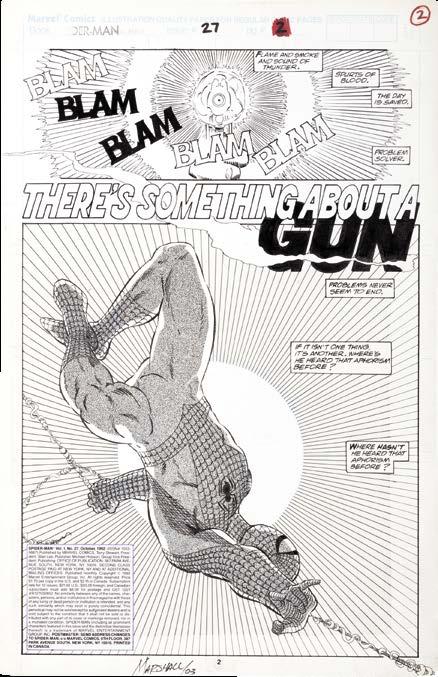
I agree that it would be a great idea to cover-feature more writers in future editions of CBC. McGregor’s fellow status quo disrupting trailblazer, Steve Gerber, feels like an obvious choice, although unfortunately he is no longer around to be interviewed. Of those writers who fortunately are still very much among the living, my top three choices
to get a cover spotlight are Ann Nocenti, Chris Claremont, and Louise Simonson, as all of them would undoubtedly be fantastic interview subjects.
Finally, the piece by Robert Menzies on Herb Trimpe’s time living in Great Britain was really interesting to me, because I didn’t know about any of this before, so it was all new information about an artist I thought I was fairly familiar with. Great work.
[Natch, your letter prompted yours truly to pop online to find any commentary on that Spider-Man story you mentioned and, lo and behold, I found just that SuperMegaMonkey’s Marvel Comics Chronology website, featuring a reply comment by someone with the exact same name, Ben! That Ben Herman posted on May 11, 2016, responding to the blogger’s observation that the tale concludes suddenly, stating, “If the ending seems abrupt, it may be because there was apparently some editorial interference. A couple of years ago, Don McGregor posted the following on Facebook about the story”:]
“An arson inspector friend of mine took my son, Rob McGregor, and I to a gun range in the Bronx, so we could use the guns. Rob was the age of the young boy in the story. And there’s a lot of behind the scenes stories with this, as well. How it almost became the first Spider-Man graphic novel? Then how it turned into a two-parter. And then, when it was finished, written, drawn, lettered, [the editor] came in and proved the old adage, ‘Power corrupts, and absolute power corrupts absolutely.’ And weakened the story I had spent months researching, and overriding [previous editor] Jim Salicrup. Still, I’m proud of the story and what I hoped to do with it, and thank Jim for believing in it. Lots of stories behind this when I write the book.”
[Well, that’s certainly intriguing! Your observation assuredly is compelling for Yours Truly to pursue a “story behind the story” feature! Thanks for the notion and for your letter, Ben. Of course, your wish for a focus on “the Gerbs” is hereby granted for this very ish, which also includes a chat with writer Mary Skrenes!
And, Ben, your mention of “Weezie” Simonson prompts me to share that I am supposed to be contributing new material to a University of Mississippi Press Conversations book spotlighting Louise Simonson, but haven’t heard from that editor in years after agreeing for her to use my interview with Weezie conducted for the Warren Publications issue of Comic Book Artist and my volunteering to talk with Weezie about her latter career… Maybe that Conversations editor is out there somewhere and can read this plea to get that much-needed project back on track…
And, come to think of it, the same appeal also goes out for the editor who replaced the late Derek Royal on the Hernandez Brothers Conversations interview collection book, to which I conducted, just for that collection, an amazingly comprehensive and revealing chat with Mario, the oldest Los Bro and the sibling who organized the boys to produce Love and Rockets in the first place. Perhaps someday! Would be great to see those two volumes in print someday soon. — Y.E.]
#33 • Winter 2024 • COMIC BOOK CREATOR Spider-Man TM & © Marvel Characters, Inc. 14
Above: Alfred Plaine, founding partner of Pyramid Books, in a photo shared by his grandson, Moss Plaine, which arrived after our focus on Norman Goldfind in CBC #30 went to press. Below: Splash page to the first part of Don McGregor’s story, “There’s Something About a Gun,” in Spider-Man #27–28 [Oct.–Nov. 1992], penciled by Marshall Rogers and inked by Keith Williams.
incoming
Chilling with Mr. Chance
Telling tales of Plague Year 1665 and a boy and his kaiju, a writer shares about his process
by DARRICK PATRICK
[Jonathan Chance is a British/Southern Californian comic book writer , award-winning filmmaker, and screenwriter. His website, says he “writes while bringing up his son and occasionally submits to voice-over gigs to further express himself over other mediums.” Recent work include Cover the Dead with Lime, and the graphic novel, The Boy Who Conquered a Mountain — D.P.]
Darrick Patrick: What was the path that led you to working professionally in comic books?

Jonathan Chance: Being a visual storyteller hailing from the independent filmmaking background, horror movies and comic books were the things that always excited me as a kid. There was this deep fascination early on. I originally wanted to be a comic artist, so I went to art college. Then my brother and I threw ourselves into making movies. Every process of the DIY was very appealing and we accomplished some interesting concepts.
Jonathan: My mother. Her kindness. She’s just a good person. Often easily we can be completely biased on the people we love. If I didn’t know her, though, I’d appreciate her genuine generosity as a person. She’s always been supportive and believed in what my brother and I were doing. You hear about people not having supportive parents, but I got lucky there. I appreciate that she influenced the man I became. In becoming gracious and humble, I attribute that to her.
Then there’s my brother. He is four years older than me, so growing up he was this great artist in high school originally and now he writes books. But our interests were similar. As kids we were into science fiction and fantasy. I was into horror a bit more than him, but he was probably the earliest inspiration for me. Growing up in the 1990s, the movies we were catching were from the ‘70s and ‘80s. That was a completely rich and incredible time for cinema. Back then, for a period, it seemed there was such a clear free reign bestowed to independent writers and directors. Michael Mann, John Milius, Carpenter, Lynch, Cronenberg. These were the greats. Their stories were smart and biting. My teenage mind was forming that this was one medium that could be thought-provoking, deep, and dark. I wanted to come up with my own stories that would be memorable and stick in people’s minds.
Darrick: Do you have any words of advice for other individuals looking to make a career with their writing abilities?
Jonathan: Find what excites you and write about it. If you’re writing something that doesn’t do anything for you, it will show. It’s like when you watch a movie that takes from other movies. The plot, or ideas, show little inspiration. Some writers write to be paid and some write for the love of creation. Try to make a great story. Try to be one of those writers. You may make less, but at least you’ll have integrity and something original to leave behind.
Next page: Cover details of Jonathan Chance’s recent work, Cover the Dead with Lime (top, with art by Hernán González) and The Boy Who Conquered a Mountain (art by Emi Utrera).
Later, after a not-so-great experience with a producer, I found myself in a situation where my mindset was, “I don’t want to rely on anyone. But I can rely on myself.” I figured if I screwed up, then it’s my fault and my decisions. Nobody else’s, and I’m fine with that. I invested in myself and thankfully it didn’t backfire! I found comic books to be a perfect visual transition from making movies. Each time, I look to find the right artist that matches the story’s mood. It’s like watching your favorite movie when the music perfectly complements the cinematography and vice versa. If a story can have a perfect alignment with its art in comics, then the comic isn’t hollow. All style and no substance. That director’s vision is there engrained in the comic creator. You want to hit on all cylinders. Each time I look to create a memorable story with depth and passion. Hopefully the reader is immersed in these worlds and genuinely cares about the characters and their journey.
Darrick: Who are some of the people that greatly influenced you while growing up?
Shut off the noise. Now more than ever there are so many distractions. Our phones and apps lure us away from focus. Take deliberate steps to work on your own voice, and everything that is brilliant, amazing, and unique about it. Use what you need: music, etc. for your process — but that’s it. We all know the importance of social media for growing an audience and pointing people toward your work, finding collaborators, networking, etc. I think it’s wise to set aside a limited time to do that and then get off. Most social media apps are purposely addictive and distracting. It’s their mission to make you want to stay on, and thus, you get nothing done.
Darrick: How do you spend your time on a typical workday?
Jonathan: I make myself a coffee and put something inspiring on. Chillwave, soundtracks, etc. Then I gather my list of notes of what’s most important to check off first. When I’m writing, I’ll write until it feels like it’s flowing like honey. With enough accomplished, I’ll take a break and check on current illustrators, colorists, or letterers to see where the progress is at with what we’re working on. Maybe post a work-in-progress on social media, catch up on emails with publishers, and do interviews.
If I’m not writing the next issue of a comic, or padding
Above: Portrait of comics writer/ screenwriter Jonathan Chance.
#33 • Winter 2024 • COMIC BOOK CREATOR 18
darrick patrick’s ten questions
Photo courtesy of Jonathan Chance.
Deodato Never Gives Up
Part two of the Mike Deodato, Jr., story with insights from Tom Brevoort and Rain Beredo
by GREG BIGA
[We learned in part one that, after he got his start in the comics industry of his native Brazil, Deodato Taumaturgo Borges Filho — Mike Deodato, Jr., to you and I — came to American comics without knowing the English language, but with a very unique approach to his work. As he began his first tenure at Marvel, Mike lost that personal touch, subverting his own career with the launch of the Mike Deodato, Jr., Studios. Here we dive deep into the fall and rebirth of the artist at Marvel Comics. — G.B.]

MADE TO BE AN AVENGER?
Beginning in 1994, after tremendous success at DC with Wonder Woman, Mike Deodato leapt into the House of Ideas by taking on the penciling duties of The Avengers. Headlining one of the top team books in history is not the common way for a “recent discovery” to enter the Marvel roster but, in the mid’90s, Mike was proving to be more than an average talent.
Tom Brevoort, longtime editor for Marvel and later to be Deo’s champion, remembers Mike’s arrival. “As I recall, editor Ralph Macchio lined him up for Avengers right at the very beginning of that Wonder Woman run. So, he wasn’t influenced by it, in particular, but rather simply by the strength of Deodato’s style. And he seemed like he’d be a great fit for the book, somebody who could synthesize the John Buscema sort of approach to the team with the then-modern ‘big figure’ style
of the Image creators.”
Mike, on the other hand, did believe his successful run with Wonder Woman factored into his being assigned a choice gig straight on at Marvel and not just his initial samples. “I think it was a combination of both,” says the artist. “I remember I did samples for Avengers, specifically, and I ended up using the same scenes again. I think it was a combination of the two.
“I remember, my plan was to make it as good as Wonder Woman, with me doing the inks and everything. But after, I think, four or five pages, my agent told me, ‘No, you are only doing breakdowns and Tom Palmer is going to finish it because we have a lot of other books that Marvel editors want you to work on.’ So, I was kind of bummed because I wanted to do my best work ever. And, if you see my first issue of Avengers, the four first pages are very, very well done. And then, it’s not. So, I could do Hulk against Hercules, a special one. I did a lot of other books while I was doing Avengers. I was doing it in this kind of style that was only breakdowns. I was doing four pages a day. So, it was very, very fast. And Palmer had to do a lot of work to make it readable.”
By 1994, Palmer was already a legend as an inker. The late giant had brought his pen to some of the greatest storylines in Marvel history. The Image era provided pencilers who were not always a great match in style with Tom. Deo shares he was among them. “Yeah, well, I loved the work he did on Gene Colan, especially. It was fantastic. [But] I was not satisfied because I was doing it in a rush. And Tom Palmer also had to do a lot of things in a rush, too. And I don’t think the result was good. It was not his best because he was working over breakdowns. And it was not my best because I was doing four pages of breakdowns per day. So, I was not satisfied at all with the results, overall. It had a lot of energy and big figures, but I was not happy, to be very honest. But you can see in the first four pages that he inked was great. So, if I were doing the pencils like I should, with his inks, the result would be much better.”
During his two tenures at Marvel, Mike would frequently return to The Avengers, a title that appears to be ‘“his book.” Deo explained, “Well, at first, it was fantastic. I was doing The Avengers the first time. And then, [on] every occasion, I would jump into
#33 • Winter 2024 • COMIC BOOK CREATOR
Inc. 22
Weapon H, Incredible Hulk TM & © Marvel Characters,
son of the flame
This page: Below is Mike Deodato, Jr.’s design for Weapon H and, at bottom, the artist in a recent photograph.
Above: In the early 2000s, the artist completely reinvented his style, now using photo reference to exquisite effect plus he rendered in pencil using a technique that did not need to be inked, as obvious in this spread from Witches [#1–4, Aug.–Sept. 2004].
Below: Mike’s head designs for Lilith, the daughter of Dracula, as she appears in Marvel’s Witches four-issue mini-series.
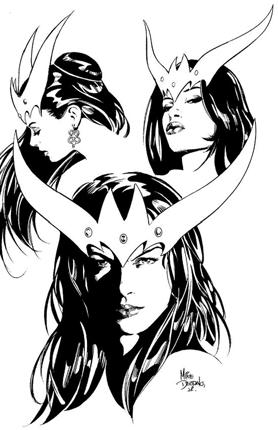
No one from DC or Marvel were calling him until Marvel began putting a book together to raise funds after 9/11. Mike would create his now iconic image of Captain America with Cap’s face in his hand for the book. He chose not to submit it for the charity book as he believed it was capitalizing on a tragedy at that time. However, Marvel was ready to forgive and forget… or so Mike thought.
“Finally, a Marvel editor gave me the chance to do a nice color story, an 11-page story,” Mike said. “I did it in my new style. I took pictures of everything, all the poses I did. It was like a gamble because I used real guns, I used a real home, I used my car, and everything. A lot of work was done with the storytelling. I was very proud. I was using this new technique that was only pencils. I did the pencils very tight. So, it not does not need to be scanned to be inked because it could scanned from the page. I sent it to the editor and the editor loved it. ‘It’s fantastic, but I cannot use it because I hired an inker and he can’t ink this. How can he ink this?’ So I said, ‘Okay, send it back and I will do it again.’ So, I did the 11 pages again on the lightbox, leaving space for the inker to ink it. So, there’s two versions of this art. I send it back and the guy said, ‘This is fantastic. I’m gonna give you the next X-Men title.’ I thought, ‘I was back at Marvel!’ And then the guy got fired. I thought, ‘Okay, starting again.’
“And then, editor Lysa Hawkins was doing a new book called The Witches, and she said I was competing with a European artist, but I never knew who it was. I sent in samples; I was working with computers now. So, I spent all my time doing colors, doing the layouts, and I even did a presentation for her
to submit the pitch to Marvel. So, I got the job. I did the first issue and the second issue. And then Bill Jemas read the script and said, ‘Oh, this is not good. We’re not even going to publish it.’ Oh, man. It was bad luck. So, starting again… I never give up. Every time I find an obstacle, it’s more incentive for me to keep going.”
TOM, AXEL, TIGRA, AND THE BIG GREEN GUY TO THE RESCUE
“Tom Brevoort saw the pages I did for Witches [which] was supposed to start years later. Axel Alonso had a script from another writer. I didn’t want to finish it and it went to a friend of mine. But Tom Brevoort had this Tigra mini-series [#1–4, May–Aug. 2002] and I took it. I’m very proud of my work, there. I did very tight pencils. I used a lot of use of Steranko and Gulacy as motivation as there was no contour lines on the figures. The contour was made by the background or the shadows. So, I put in a lot of effort and I was not satisfied at the time with the colors. Because I thought they took out my effort from doing the colors too heavy, I thought, at the time. Now I’m very proud of the colors and everything. After that Axel got me back into Marvel. He saw my style and was a big fan. So, he invited me to do The Incredible Hulk [#50, May 2003]. And that’s when I consolidated my plate at Marvel and signed a new contract.”
Deo sees Brevoort as instrumental at bringing him back to Marvel. Tom humbly deflects that statement: “I think instrumental gives me too much credit here,” the editor says. “At the turn of the millennium, Deo had been away from mainstream comics for a little while and he was looking for work. His reputa-

26 #33 • Winter 2024 • COMIC BOOK CREATOR
TM & ©
Inc.
All characters
Marvel Characters,
Steve Gerber
To be honest, the list of comic book writers whose prose and storytelling consistently blew my mind as a teenager was a pretty short one. While I really enjoyed Bob Haney and Doug Moench’s respective work — and Roy Thomas remained my favorite writer/ editor — there were three scribes working at Marvel whose efforts truly nailed those crazy, uncertain days of the early to mid-’70s. Don McGregor and Steve Englehart had been truly saying something life in that time of liberation, ecological awareness, Vietnam, and Watergate. And there was another who especially captured the insanity of that nutty age.
Ed Menje: This is “’Nuff Said!,” and we got an interesting show planned for you. We got Steve Gerber, the man who created Howard the Duck, and did a whole bunch of other stuff… We enter the wild, wacky, wonderful world of that West Coast wunderkind, Steve Gerber, that Sage Sultan of Stirring Sagas and Doctor of Duckology, the creator of Howard the Duck, who has also lent his prodigious pen to presenting peerless parables of the Man-Thing, Superman, Spider-Man, the Defenders, and the Hulk. We’ll also confab on his current creative conquest for Ultraverse, Sludge… [cites station identification and refers to musical interlude] You heard musically “Cold Metal,” by Iggy Pop and the Howard the Duck theme song from the film, from the climactic scene where Howard and Beverly’s band gets up on stage and plays that wonderful music written by Thomas Dolby. And I’m Ed Menje.
Ken Gale: I’m Ken Gale.
Ed: And on the phone we got Steve Gerber. Steve Gerber: Hello.
Had he not passed away in 2008, Stephen Ross Gerber would have turned 76 by the time you read these words. During the era discussed, he had cultivated a reputation as a writer with an appetite for the absurd while rocketing to popularity at the House of Ideas. His satirical touch was perfectly attuned to those pretty stoned years, and subsequent struggles in his crusade for creator’s rights defined, in comics, much of the coming decade. As writer, his talent is sorely missed and, as a person, Steve will never be forgotten. Following is an edited transcript of a live radio interview broadcast on February 2, 1994. — Ye Ed.
Ed: Hello. So did the Howard the Duck music bring back bad memories?
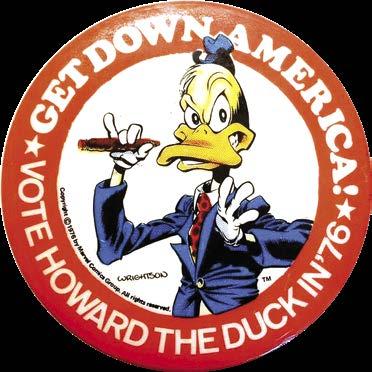
Steve: Actually I could barely hear it over the phone. So, it didn’t have a chance to bring back… There are some good memories associated with it all. So, I was at one of the recording sessions — or rather one of the [music] video filming sessions — that they did for the movie. The video, I think, played about half-a-time on MTV, and it was nice to meet Thomas Dolby and some of those people…
Ed: When did you start in comics? What year are we talking?
Steve: Oh, 1972, actually; 22 years ago… 23½, actually. It was June of 1972.
Ed: What was your first book?
Steve: The very first thing I ever did for Marvel, I believe, was a plot for a “Man-Thing” story. That was not the first “Man-Thing” that appeared on the stands, but that was the first thing I ever wrote for them.
Ed: So what was the first thing that appeared on the stands?
Steve: Probably the first issue of Shanna the She-Devil [Dec. 1972], which I
#33 • Winter 2024 • COMIC BOOK CREATOR
30
Howard the Duck TM & © Marvel Characters, Inc.
served as additional dialogue. Carole Seuling had written the original script… Nice lady.
Ed: So you began with “Man-Thing” [in Fear], which you took over…?
Steve: Yeah, that was the very first thing I did for them. And it was curious, too, because I had just read the introductory story or one of the introductory stories… I think they had done a guest shot with the character in “Ka-Zar,” or something like that, prior to my working on it, and I had just finished reading that and got my first assignment over the phone — I was still in St. Louis when I wrote it — from Roy Thomas.
Ed: So how did you know Roy?
Steve: Roy and I go back many, many years, to the time when I was actually about 13 years old. We met through a letter column in Hawkman… that’s basically it. I mean, you know, Roy had written some letter to Julie Schwartz’s Hawkman comic, talking about the old Justice Society characters in the earlier versions of the various DC characters. And it sort of piqued my interest. And he also lived in Missouri about… I don’t know… probably about 80 miles from where I lived. So I dropped him a note and asked him about this stuff and, you know, actually had the gall to say, “Well, gee, can you send me some pictures of these characters? I’d really be curious to see what they looked like.” And, amazingly, he was gracious enough to respond and actually loaned me a few Golden Age comics through the mail, if you can picture that. Which was how I kind of got my grounding in all of the stuff that came before 1960 or so. Ed: So you were pretty new to comics then?… If you didn’t know who the Justice Society was and you were reading Hawkman, you must have been pretty new to comics.
Steve: Well, no. I was born in 1947, so, by the time that I was old enough to read, the Justice Society was virtually gone, and I had never seen those books. I remember the Superman and Batman books from the early ’50s. Some of those are still dearly and fondly remembered, but I had never seen any of the other super-hero characters, other than Superman, Batman, and Wonder Woman. I didn’t know there were any [others].
Ed: So you knew Roy and he invited you to write comics. Is that how you got in?
Steve: Basically, that’s it. I was working in advertising in an agency in St. Louis, and writing savings and loan commercials, and that sort of thing. Roy had just been promoted to editor of Marvel Comics, and I dropped him a line, at some point, and said, “Look, I’m going crazy. I can’t write another, you know, savings and loan jingle or I’m going to lose my mind. Is there anything open at Marvel?” And, coincidentally, I had written him at exactly the time Marvel had started to expand. Stan had just become publisher as opposed to editor… The conglomerate that would be so near and dear to my heart in later years, Cadence Industries, had just bought Marvel and they were right on the verge of their first major expansion. So, basically, he said, “Yeah, we’ve got something.” Sent me a writer’s test (which I don’t know if they do anymore). I took it, sent it back to them, and they said, “Yeah, you’re qualified.” So that was how I got the job at Marvel.
Ed: Your first job was dialoguing Shanna?
Steve: I worked as a proofreader and editorial assistant in the office, and my first actual scripting job for Marvel was the first issue of Shanna, the She-Devil.
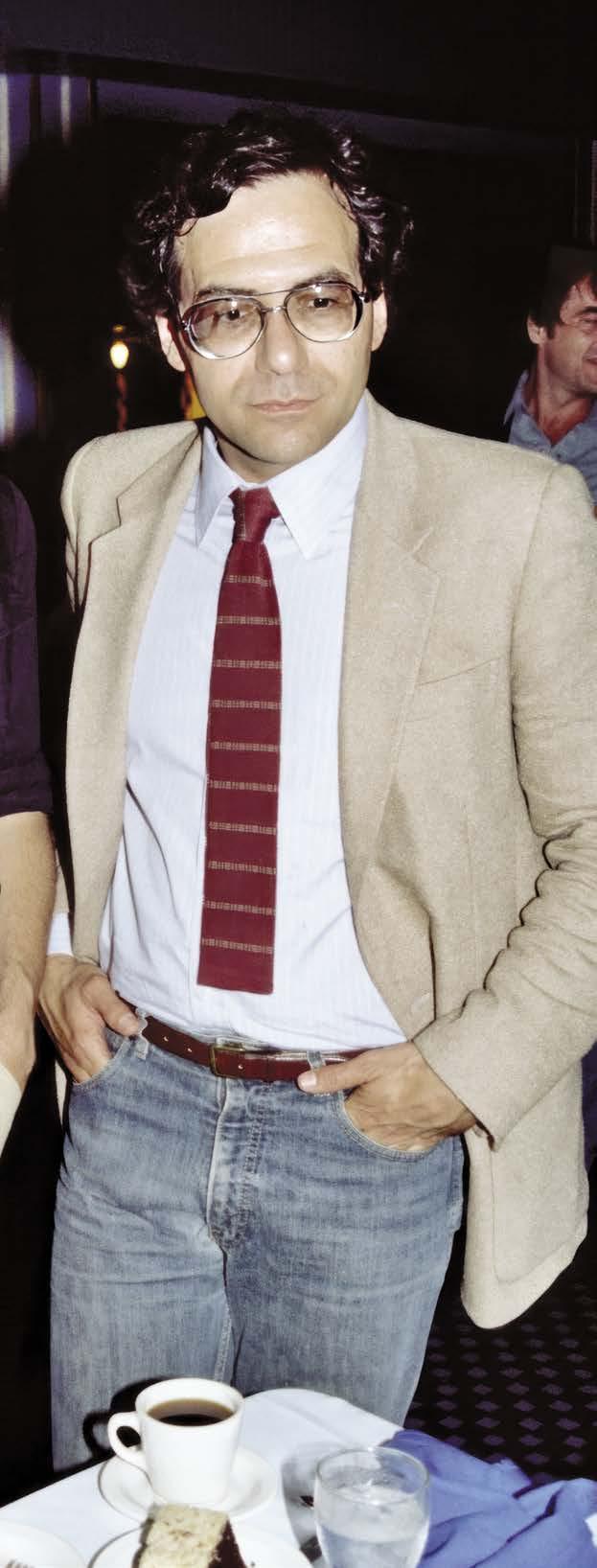
Ed: What a great beginning.
Steve: A peculiar beginning, anyway. It certainly doesn’t happen that way anymore.
Ed: Marvel was pretty different in those days… What was it like?
Steve: Oh, Marvel was a madhouse in those days. There were 15 people in an office. We were at 625 Madison Avenue, corner of 56th, 57th, something like that, down as far up as 57th. It was like a block or so below. And the office was about the size of the editor’s office [today]… a tiny little place with about 15 or 16 people there. And we turned out all of those books from that tiny office. Well, not the writing and drawing, of course. Those were done by freelancers, but the editorial staff was all contained in that little office. And somehow we managed to get out everything we needed to do.
Ken: Yeah, I sort of joined comics just a few years later and the thing I remember most is all the parties. Every week there were anywhere from one to three parties.
C OMIC BOOK CREATOR • Winter 2024 • #33
Photo by Alan Light
31
Photo courtesy of Alan Light.
Steve: Well, I don’t know. I was a family man in those days, so I didn’t get to too many of those. That came later for me, I guess. You know, post-divorce. But it was an unusual time in comics because there were an awful lot of young people coming into the field at that time who, prior to this, virtually everyone in the comics had had come in during the 1940s, a few during the ’50s, and, all of a sudden, there was this enormous influx of new people and all of us roughly the same age, all of us strangely seemed to be from the Midwest, which I can’t explain. But it does seem to be the case. And it was a very unusual time. I mean, everyone was learning the whole science of comics all over again, from the start.
Ken: I was doing some research for this show, I noted that you were [designated] the “Funniest Boy of 1965.”
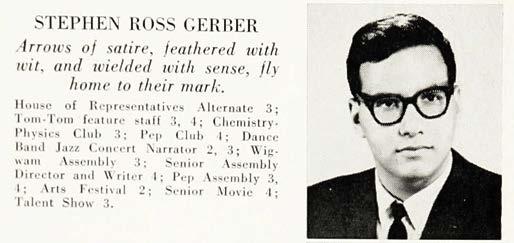
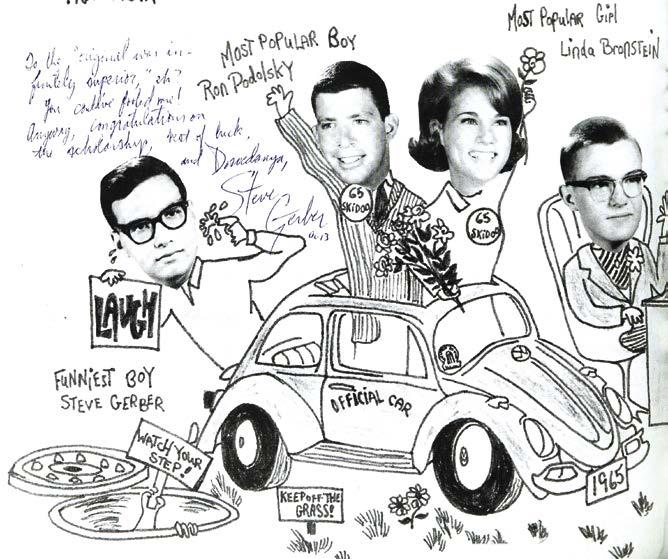
Steve: God, where did you get that one?
Ken: You wrote it.
Steve: It’s true. Was that in the “Deadline Doom” [Howard the Duck #16, Sept. 1977] issue…?
Ken: I think that was in “The Kids Night Out” [Giant-Size ManThing #4, May 1975]
Steve: Oh, could be. Yeah, it’s true. University City High School, Class of ’65.
Ken: So what did you do to be to become “Funniest Boy”?
Steve: It was mostly the stuff that I had written for the school paper, and school assemblies, and stuff like that.
Ken: “Kid’s Night Out,” since I’ve mentioned it, was a Man-Thing story about the trials and tribulations of being a fat teenager. Was that autobiographical at all?
Steve: If I hadn’t been inclined to write, I could have grown up to have been [former fat kid and exercise guru] Richard Simmons. It’s a horrible thought, but it’s true. I was, you know, the kid that was picked last to play softball and for the team, and the one who tripped and fell all over himself every time he had to run the 50-yard dash. And all of that stuff.
Ken: Did you have a gym teacher like the one in that story?
Steve: All the gym teachers are like the one in the story. They’re all one person. They’re all clones of each other… There is no other gym teacher. It’s like the joke about the Christmas fruitcake. There’s only one of them and it gets passed to different people each year, right? There’s only one gym teacher in the whole world. [And] that’s the gym teacher.
Ken: Well, was there a [real] girl like [the one in the story]…?
Steve: The answer is no. That was fictionalization and wish fulfillment. One interesting thing about [the story] was that I had actually waited to write it until I was no longer overweight. It was it was one of those things where I wanted to make sure that I still felt that way, you know, after I could walk down the street without people going… you know… And I did, in fact, feel more strongly about it.
Ken: Now was that story in Giant-Size Man-Thing #1? Because that was a pretty heavy story for those days… What kind of reaction did you get at the office when you turned in something like that?
Steve: Well, the major reaction at the office was, “When the hell are you going to get this story [done]?” And because it was so late… That was probably the hardest story, the most difficult story I’ve ever written, and it took a long, long time. But the reaction to it was generally pretty positive. I mean, actually, that story would be much more difficult to do today than it was in whenever that was 1974 or so.
Ken: Why do you say that?
Steve: Because people these days, readers seem to be less receptive to comics stories that are about much of anything.
Ken: Despite the influence of people like Alan Moore, Neil Gaiman, and Frank Miller?

Steve: Yes, despite that. Even Alan has experienced some of this. I mean, look at the huge reception that Big Numbers got. You know, the Frank Miller stuff is unusual in that, although he does very good stuff… he’s also a very good friend of mine… but it’s very definitely clearly within that action/adventure genre of not necessarily super-hero stuff, but almost always something you’d expect to see in an action movie. You know, that kind of thing, which is not a criticism. I love his stuff. I think it’s terrific. But the kind of stories that I was doing back then that had a lot more to do with people who were just people are almost impossible to write these days. The fans don’t want to read them.
Ken: So would you say that comics have taken several steps backward since the ’70s?
Steve: In some ways, yes.
Ken: What happened?
Steve: Oh, boy! I’ve got to be a little bit ginger about this [laughter] because I don’t want to mention too many names. But basically Marvel, during the 1980s, was so homogenized — the product that they were churning out — that a whole generation of readers was created, who didn’t know that comics could be anything other than a bunch of costumes fighting each other. And it spoiled the market. It really has. I don’t want to lend the impression that it’s exclusively that or that I’m, you know, down on the readers or down on the market or anything, but it’s changed. There is not the open-mindedness, there’s not the curiosity about what can be done with the medium that was
32 #33 • Winter 2024 • COMIC BOOK CREATOR
Above: Low-resolution photo of “Nuff Said” radio show hosts Ken Gale (left) and Ed Menja.
Previous spread: Steve Gerber collaborator Mary Skrenes ran the 1976 Howard the Duck presidential campaign, enlisting buddy Bernie Wrightson to render the waterfowl. Photo of Gerber by Alan Light taken at the 1982 San Diego Comic-Con.
Below: Items from Steve Gerber’s University City High School senior class yearbook, where he was given the “Funniest Boy” superlative for the Class of 1965. Note the future writer’s inscription. (Gerber’s alma mater is located in St. Louis, Missouri.)
there 20 years ago.
Ken: Well, that’s an interesting way of putting it: lack of curiosity. Although now, of course, in the ‘80s, when you had a whole bunch of new companies come up…
Steve: Right, in the early ‘80s.
Ken: And certainly Eclipse was continuing the type of things that you did.
Steve: Right.
Ken: So you’re sort of putting it, “Since Marvel is sort of the way people think of comic books, when Marvel takes a step back, then the industry is sort of taking a step back with them.”
Steve: Well, I’m just trying to be a little bit realistic about it. I mean, in terms of the number of books sold by any of these companies, Marvel (until, really, about the past six months or a year) had about 60% of the comic book market — 60% of everything that was sold — certainly in what we call the direct market, the comic book stores, as opposed to the newsstands. And Marvel Comics were the books that people learned to read comics from… you know, gained most of their ideas about comics from. What happened to Marvel in the ’80s, I think, shaped a whole generation of readers.
Ken: Well, yeah, it makes unfortunate sense.
Steve: It does. I’m sorry to have to say it myself. I’m not sure that isn’t changing now. I think it’s on the verge of changing if it hasn’t yet, but it’s taken a long, long time to do it.
Ken: What do you think is changing it?
Steve: I think people are getting tired of this formula stuff. It’s inevitable. I mean, these things do go in cycles, but they go in very long cycles sometimes. This particular cycle of super-hero stuff has lasted longer than anyone has ever seen it last in the industry before that. That does seem to be changing somewhat. I mean, even the newer super-hero characters that are being done these days are quite a bit different from the things that were being done at Marvel during the ’80s.
Ken: For example…?
Steve: I’m working on the Ultraverse line of comics and the one example I’d cite right away is one of the more prominent characters from that line, called “Prime.” It was written by Len Strazewski and Gerard Jones and drawn by Norm Breyfogle. And it’s kind of a really perverse twist on the Captain Marvel idea. It’s being done in a way that I’ve never seen it done before, and it has gained a certain level of acceptance with the audience. People do like it. You know, it’s still because of the current state of the market, the depressed state of the comic book market at the moment. It’s still having a hard time, you know, breaking through the barriers to a lot of new readers. But it’s getting there. It’s making progress slowly but surely.
Ken: Let’s get back to your stuff at Marvel. Now, was it you who came up with the “whatever knows fear burns at the touch of Man-Thing”? Is that yours?
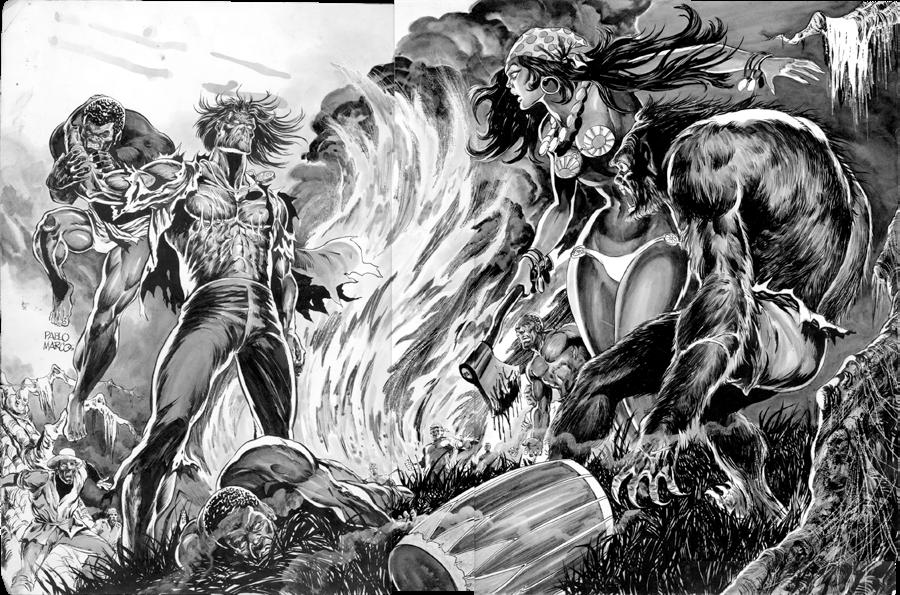
Steve: Well, I don’t know… I didn’t come up with the power because the character was created before I worked on it. I may
have come up with the line… I honestly don’t know. Ken: Because I connect Man-Thing so much with you that I really don’t remember anything Gerry did with it.
Steve: Well, there are only two or three stories that were done before I worked on it. One, the very first appearance of the character, I think, was in the very first issue of a book called Savage Tales [May 1971], a black-&-white story that was drawn by Gray Morrow and written by Gerry Conway. And then, as I said, there was that “Ka-Zar” story and one story in Fear before I took it over. And I believe that’s it. I wrote all of the rest of them throughout the ’70s.
Ken: Yeah, I noticed you’re so good at writing dialogue and comic books themselves are so dialogue-oriented, and yet the Man-Thing stories you wrote were very caption heavy.
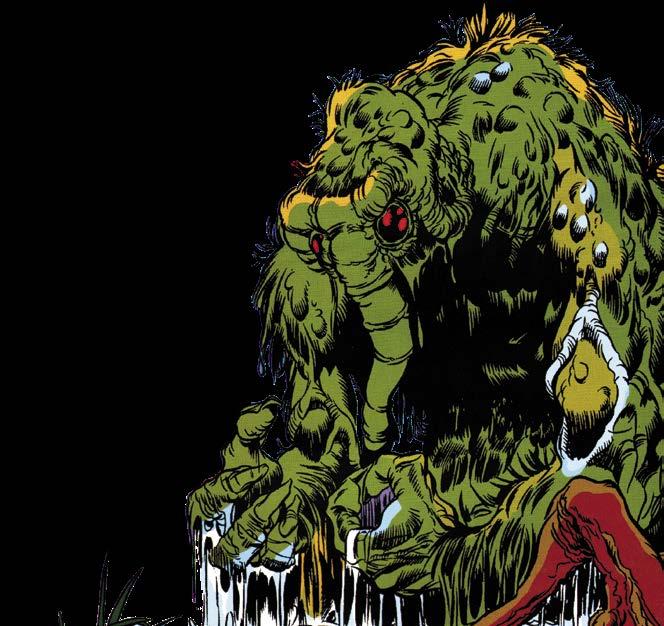
Steve: I had a lead character who couldn’t talk.
Ken: Yeah, I mean, it’s an interesting choice, especially when [you were] sticking with it for so long… It’s an inter esting challenge having to write a character who doesn’t talk, who doesn’t think… all he does is feel.
Steve:
acters for a while in the ’70s. It was a nightmare, really. I was also writing a book, I don’t know if you remember it, called Did you ever see that one?
Ken: Oh, yeah.
Steve:
dead guy, and he also barely spoke a word or two, here and there. Couldn’t feel anything and really didn’t even have Man-Thing’s empathic nature to go on. He just sort of walked around being dead and involving himself in stories. And I got my fill of characters like that by the time I left
Ken: But you did so many of them. Were you being typecast or you just…
Steve:
Above: Gerber received some unusual assignments as nascent scripter at Marvel Comics, including the black-&-white horror series in Tales of the Zombie, where he chronicled the un-life of Simon Garth. His stories were usually drawn by Pablo Marcos, who produced this exquisite illustration. Below: Another excellent series (sometimes drawn by the excellent Mike Ploog) written by Gerber was Man-Thing. This panel detail is from Giant-Size Man-Thing #1 [Aug. ’74].
The Zombie, Man-Thing TM & © Marvel Characters, Inc.
C OMIC BOOK CREATOR • Winter 2024 • #33 33
Ed: Yeah, it could have been because the guy they gave it to (I don’t want to mention Ralph Macchio by name)… but he didn’t like rock ’n’ roll. He boasted as much in the letter column and it showed in the script. And I am so surprised that everybody at Marvel was surprised that it didn’t sell as well as yours.
Steve: Huh? Well, I don’t know if it would have anyway, to be honest with you, the first one was something so unusual and so unprecedented that I think a lot of the sales were simply due to that. The second one… I don’t know. I’ve never read it. So I don’t I can’t tell you whether it was any good or not… [Discussion of a gimmick used to promote the KISS book].
Ken: We have some of our listeners wondering what we’re talking about.
Steve: As a promotional thing for the book, the four members of KISS went to the printing plant where the book was printed and the samples of their blood were withdrawn from their fingertips and placed in the ink that was used to print the book. Somebody said, nowadays you couldn’t sell that book. Everybody would be afraid of catching something from it. And it’s probably true. [The show is opened for listener callins.] Watch… It’s Ralph Macchio… Why don’t you let me say something good about him? Because, again, I’ve never read the [second] KISS book, and it may be as bad as you say it is. But Ralph is a very good editor. I’ve worked with him extensively at Marvel and I enjoy working with him a lot. He’s a quite good friend of mine. [First caller questions about Todd McFarlane omitted.]
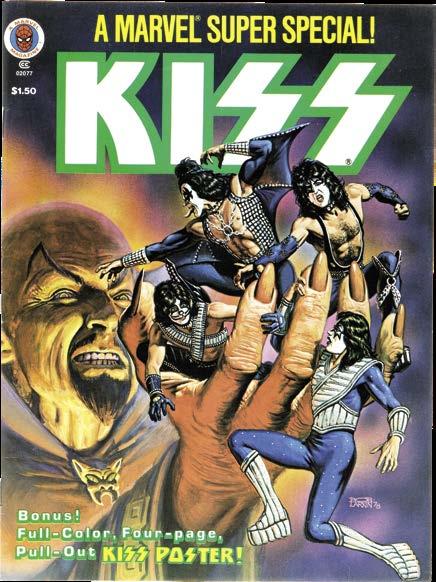
Ken: Hello? You’re on the air.
Caller Two: I know you just talk about comics, but I was curious: do you guys ever tackle writing stories about serious subjects like… racism?
Steve: Umm, I don’t want to pat myself on the back.
Ed: You’re talking to one of the best people in that genre of comic book writing. Steve Gerber wrote some of the most entertaining and progressive political comics to this day.

Steve: Thank you.
Ed: You’re welcome. Thank you. I enjoyed reading them.
Steve: A nice compliment. Thank you very much.
Caller Two: [After a discussion of racists are simpletons] I
remember, long ago, it must have been late ’50s/early ’60s of a Superboy, which had an alternative uni verse of Superboy, never came to Earth and grew up on Krypton. And Krypton had a socialistic government and Superboy wanted to go into a particular field, but he wasn’t allowed to. And I just didn’t know how to interpret that whole thing, whether it was pro or con. Do you recall anything? You know something…?

Steve: I do. I do recall that book. I probably read it at about the same age you did. It’s a Superman story that takes place entirely in the Fortress of Solitude, actually. And Batman and Robin show up for Superman’s birthday. (Can you believe I’m doing this? Would you believe I remember this stuff?)
Ed: That was an Alan Moore story… Steve: And computer program that would show him what his life was like had Krypton never exploded…
Ken: Did he have two S’s on his chest…?
Steve: Jor-El shoots him into space. And then the planet, they managed to stabilize the planet and they bring the rocket back. And it’s not a socialistic government, as I recall. It’s a technocratic government. The computer picks an occupation for him.
Caller Two: Nevertheless, he wasn’t [getting] the occupation that he wanted.
Steve: Yes, right. He wanted to be a starship pilot and they wouldn’t allow it. They… I can’t recall what he ultimately had to become, but that’s absolutely right. That is the way the story went.
Caller Two: [Refers to absurdity of Nancy Kerrigan/Tonya Harding scandal of that time period] It seems like we really have to turn to comic books to get the serious news.
Steve: Sometimes I felt that way, believe me, that we were doing more serious things in comic books, certainly than they would allow on dramatic television, at any rate. Yes.
Caller Two: Certainly this whole subject of racism and superiority, because, uh, that was the whole thing about the Nazis. And this is the thing I would like to see. [After discussion of Hitler hating Superman.] Certainly this thing about people being divided amongst themselves to keep off the management’s back, such as politics itself. And this whole idea of elitism, I think, should be the thing to tackle in the comics would be terrific.
Steve: Well, again, I would
THANKS to all the folks who helped with this Gerberthemed “Main Event” section, including: Mark Arnold, Paul Baresh, J. Michael Catron, Shaun Clancy, Heather Devitte-McKee, David Donovan, Steve Englehart, Ken Gale, Jeff Gelb, Clay Geerdes, Glen Gold, Alex Jay, Alan Kupperberg, Val Mayerik, David Miller, Lou Mougin, Ralph Reese, Eric Reynolds, Jason Sacks, Cory Sedlmaier, Mary Skrenes, Hugh Surratt, Alan Weiss, Pauline Weiss, and Michelle Wladich.
This page: Clockwise from bottom is Fear #17 [Oct. ’73] cover by Frank Brunner; the KISS Marvel Super Special Gerber did not write [#5 Dec. ’78], Bob Larkin cover art; and cover detail from Phantom Zone #1 [Jan. ’82], Gene Colan and Tony DeZuñiga art.
39 C OMIC BOOK CREATOR • Winter 2024 • #33
KISS TM & © KISS Catalog, Ltd. Marvel Super Special, Fear, Man-Thing TM & © Marvel Characters, Inc. Superman, Phantom Zone TM & © DC Comics.
Above: It is said this is the unused version of Howard the Duck #12 [May ’77] cover, the postal delivery of which was delayed when it was temporarily lost, so Gene Colan and Tom Palmer did an exact replication (presumably based on Colan’s pencils) to meet the Marvel deadline Below: Was it Tricky Dick who appeared as a member of the Entropists cult in Giant-Size Man-Thing #1 [Aug. 1974]? Gerber doesn’t remember! Art by Mike Ploog and Frank Chiaramonte.
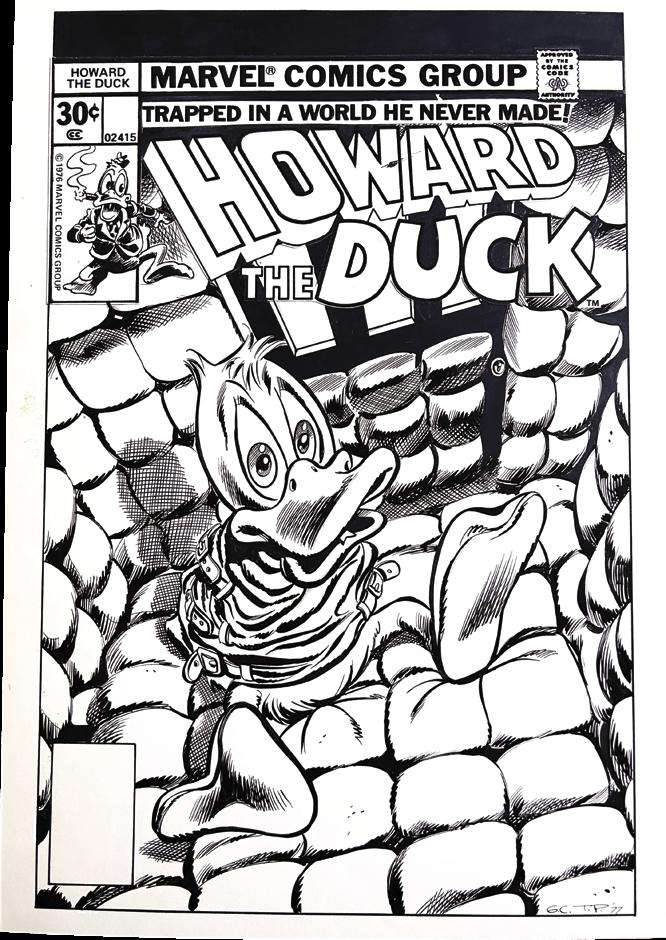
recommend to you some of the Ultraverse books that we’re doing now. The there are more government conspiracies going on in these books than even I can keep track of. And one of the books is actually one of the characters is actually a corporate super-hero created by a corporation for a corporation, a character called Prototype that’s being written by Len Strazewski and Tom Mason. And Len also does writing for one of the financial papers and so has a pretty good insight into the way corporations work and the way they’re run. And I think you’ll find some interesting stuff in that book if you try it.
Caller Two: How about Ralph Nader as a character? As a super-hero?

Steve: Hasn’t been done yet, but it’s a good suggestion. Caller Two: How about Anti-Racist Man?
Steve: You know, there’s an entire line of books being done now. Actually, two of them, founded by minority creators and those books actually are doing quite well. They’re not entirely, you know, themed around the question of racism and shouldn’t be, I don’t think, because, you know, the people do have more than one concern in life. Even if that’s something that they have to deal with every day. But those books are doing quite well. There are a series of books under the Milestone imprint, and I forget the other one… It’s all interesting stuff. And all of these things
as aspects of life do get dealt with in comic books. There’s a reason, I think, that we don’t, for example, have an Anti-Racist Man, you know, as a comic book character or Captain Equality or something, because kids, in particular, and adults, too, don’t really care to be preached at that much. They’re happy to look at various different aspects of life within the context of a comic book story… To take your example, you were talking about Superman earlier: the fact that he’s an alien, for example, can be used as all sorts of metaphors, you know, for racism,for individuality, for all sorts of things. Howard The Duck was another character that was literally a minority of one on the planet. You know, the only duck walking around. And you can use characters like that to make those points without hitting people over the head with it, if you know what I mean. [Short talk about violence and Caller Two exits.]
Ken: Hello, you’re on the air.
Prank Caller: [Burping sound]
Steve: Howard. Hi. Stern. Not the duck.
Ed: I’d rather hear the duck. Hello, you’re on the air.
Another Prank Caller: [Maniacal laugh]
Steve: [After third Prank Caller] I thought you had to call out to get those numbers. [laughs] I didn’t know they’re now calling you. I’m sorry. Go ahead.
Ed: One of the stories in Man-Thing you wrote quite a while ago…? Do you recall the story where there was a group of people setting up their own — I don’t know — ecosystem with geodesic domes where they didn’t have to use any energy. Everything was self-contained and so that they didn’t do anything to the environment. They were part of the environment. And you created some sort of anti-environmental cult that ended up opposing them.
Steve: Yeah. The Entropists, you’re talking about.
Ed: The leader of the Entropists looked an awful lot like Richard Nixon…
Steve: It looked exactly like Richard. That’s the sign of the times. The story was done in, what, 1973 or ’74…?
Ken: Seventy-three or ’ 74. Was that your idea or the artist’s?
Steve: I honestly don’t recall. I want to say it was the artist’s. Because I remember seeing it and bursting out laughing at how well he had done it. But I really don’t remember.
Ken: That’s just what we were talking about with the our last real caller, as far as putting those kind of messages in the story. Because it was done in a very entertaining way, although I think part of it because the humor of having Nixon in there as the…
Steve: Nixon was good for a laugh, no matter what you did. Yeah, it’s you could have put him anywhere behind the counter in a general store. He would still have been funny…
Ken: You had mentioned Superman earlier. The only stuff you did for DC is some Superman stuff…?
Steve: No, there were a few things. I wrote a Metal Men story [#45, May ’76] that Walt Simonson illustrated in the early ’70s and the Superman Phantom Zone mini-series [#1–4, Jan.–Apr. ’82]. And, later, I did the last issue of DC Comics Presents [#97, Sept. ’86], a story where we had Argo City fall to Earth and the Bizarro World blows up or implodes, actually. And it seems to me there are one or two other things… DC and I never had a whole lot of luck working together. I like a lot of the people there but, for some reason, every project I ever tried to do with them just, you know, withered and died horribly… I mean it. Some of them never got off the ground. Some of them got as far as having a book drawn and never quite… my wanting changes or something and not being able to get them… Various different things. It’s just almost everything that I ever tried to do with them just didn’t work out.
40 #33 • Winter 2024 • COMIC BOOK CREATOR
©
Howard the Duck cover TM & © Marvel Characters, Inc. Courtesy of Glen Gold. Man-Thing panel detail
Marvel Characters, Inc.
Mary Skrenes
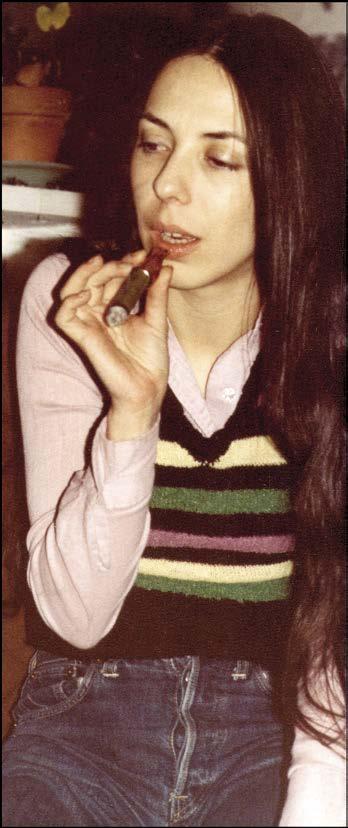
There’s a photo of the writer in an Academy of Comic Book Arts newsletter from June 1973, and it sums up how I had envisioned Mary Skrenes over the years. It’s a candid shot of the ACBA Shazam Awards banquet with a standing Bernie Wrightson leaning to talk with seated Skrenes, and all one sees is her straight, long hair, her facial features hidden (just like Smilin’ Jack’s pal, Downwind, whose face was always concealed). A woman of mystery!
Comic Book Creator: Where are you from?
Mary Skrenes: Well, I grew up in Vegas, from the time I was one.
CBC: And the kind of life that you had, was it suburban, pretty much?
Mary: Yeah, I grew up in a little neighborhood with trees and single-story houses and kids playing football in the street. I lived two blocks from the school I went to, and the church we went to, and two blocks from “the Strip.”
CBC: What was Vegas like in… I guess this would be the days of the Rat Pack, pretty much…?
Mary: Yeah, it was around that time. [laughs] It was a small town. It was… Oh, gosh, I don’t even know how many people it had. [35,000 then and now 28,000,000 — M.S.] There was the Strip, and all of the entertainment, lavish shows with full orchestras and showgirls with tall feathered head dresses, and headliners like Frank and Dean and Sammy and… the Mob. They weren’t overt about it, but they had their reserved booths at shows and the many gourmet restaurants.
It was just a nice, quiet town where people could raise their families. People were always surprised that families actually lived here. [laughs] And they thought that nobody had running water, outside of the Strip. It was a very conservative town. I think it probably had more churches than any other small
Well, of mystery comics, anyway, as she contributed to the Joe Orlando books at DC back in the day, usually under the pseudonym, “Virgil North.”
But she was most prominent collaborating with Steve Gerber, when they jammed on Howard the Duck and, in 1976, they cocreated Omega the Unknown.
This chat was conducted on Super Bowl Sunday 2005 and, after my insistent nagging, she finished the copy-edit and also added a few notes. — Ye Ed.
town. The entertainers went to church, everybody went to church.
CBC: Did you see celebrities with any regularity?
Mary: Well, yes, I did. I saw Danny Thomas, sitting in his car, waiting outside church for Marlo. [laughs] My father opened the first 24-hour laundromat in Las Vegas, which had the first coin-operated dry-cleaning machines in it, and so I would see celebrities in the laundromat. [laughs]
CBC: Oh, yeah? Like who?
Mary: Oh, like Pat Boone. And my dad was in real estate, and he sold houses to the Dukes of Dixieland. I remember seeing the Mills Brothers, who were awesome. And Dad also managed a little shopping center that was on Sahara, a couple of miles from the Strip. Celebrities came there for groceries and the shoe store and the barber. I mean, people did their own errands back then. They didn’t have entourages.
CBC: And where’d you get exposed to comics?
Mary: Well, my dad was in favor of comics. He read the Sunday funnies to me every week, and he bought me comic books. He bought me Tarzan and Uncle Scrooge, my favorite, because I loved all the adventures that they went on. And Little Lulu, and Disney comics.
I had the biggest stack of comic books in the neighborhood and, because
by Steven E. Tice
#33 • Winter 2024 • COMIC BOOK CREATOR 46
•
Conducted by Jon B. Cooke
Transcribed
‘Dark Figure of Mystery’ (and Friend of Ol’ Gerber)
of that, I found out that there were more than pictures, that there were actually words in these comics. I would pass them out the window to my friends when I was supposed to be taking my nap. [laughs] And I said, “I can read these faster than you.” And the kid from down the block, who was a couple years older than me, said “You’re not reading the words.” Then, all of a sudden, I saw the word balloons, I saw the words! I had to learn to read, but I had to wait. I had to go to kindergar ten and then first grade before I could learn to read. It was really frustrating.
CBC: Was it telling that it was a competitive thing that got you off? [laughs]
Mary: No, it was just, I just hadn’t noticed the words before. I mean, my dad read them to me. All of a sudden, it just clicked. So, I had to know how to read those words. But, in those days, they didn’t have Sesame Street or preschool. Everybody knows how to read before they get to first grade, today. I had to wait, wait, and wait. [laughs] So comics were pretty important to me.
CBC: And did you also watch television and get exposed to radio?
Mary: Well, radio. When I was about four, I’d turn on the radio and I’d hope
CBC: Now, you told me you took a liking to science fiction. Did you go to movies in the ’50s and stuff?
Mary: I remember going to the Huntridge Theater. It would be Flash Gordon or Buck Rogers or Superman. The neighbor kids and I would go every Saturday morning. There’d be a serial and a cartoon for 25¢ and it would last about two hours. It was close enough to walk. Nothing was too far from where we lived. When my parents took us, we only went to Disney movies.

CBC: Why the restrictive upbringing, do you think, in retrospect?
Mary: Because my parents were… They were really good people and worried about “bad” influences. I think they were really kind of afraid of the world, and they believed that everything was a threat.
My father was in business for himself. He built and managed a shopping center for a client. He was a real estate broker and put a laundromat next door in the center. My first paying job, at age 12, was cleaning the office and laundromat. Later, in high school, I managed the laundry during the summer.
I always liked creating little business things for myself. I sold advertising for the high school newspaper. Then, in college, I kind of took over the newspaper, . I sold advertising and, over the first summer there, I switched
This spread: Mary Skrenes (pronounced SKREE-nez) takes a toke of a cigar in this 1970s’ pic. Above is her, Steve Harper, and Bernie Wrightson at Shazam Awards banquet. Below: where it all started, the 1969 New York Comic Art Con luncheon, with Mary seated next to DC editor Dick Giordano (the guy with sideburns and back to camera), who accepted her first comics work, and smiling pal, Alan Weiss, and his girlfriend, Pami, to Mary’s right.
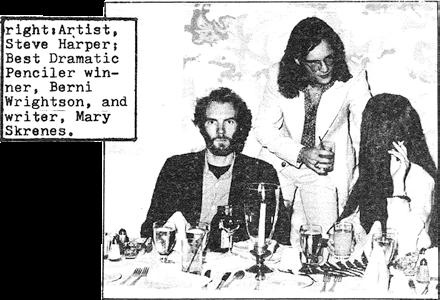

47
This page: Clockwise from above are two of the Dell comics Skrenes read as a youngster, Edgar Rice Burroughs’ Tarzan and Walt Disney’s Uncle Scrooge; her senior portrait from the 1965 Bishop Gorman High School yearbook; the landmark Huntridge Theater of Las Vegas, where young Mary Skrenes and other neighborhood kids would pay 25¢ to attend Saturday morning matinees that would feature Flash Gordon, Buck Rogers, and Superman movie serials and cartoons; and a vintage Las Vegas postcard from around 1960, the days of the fabled “Rat Pack” of the Vegas Strip, but depicting a “civilian” section of “Sin City,” away from the gambling casinos.

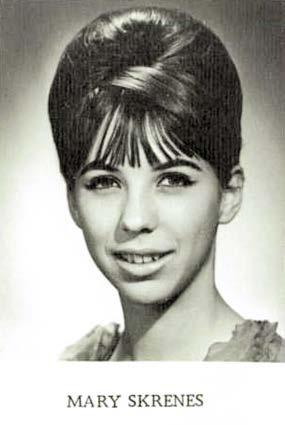
printers (which saved about 75%) and raised the advertising rates. My moxie pissed off the new editor, but the upper echelon loved it, made me the business manager, and gave me an office at the paper.
Because of my dad, I was prepared for an ethical, hard-working business world. When I got out there, I was appalled at how businesses were actually run, especially comics. It was just absurd to me, the way they ran the business. They treated people like serfs and didn’t have any expectations of creative types talking back or negotiating.
Joe Orlando was dumbfounded when I told him what hours I would come to DC to do the letters pages. I said that I would only take the job if it was understood: I kept the raise Carmine gave me if I stopped doing those pages.
I think Gerry Conway was the only other person in comics who saw it professionally. He was, like, 18 or 19 when I met him. He negotiated his way everywhere. There was no other person who saw it that way. [laughs] He was always the one to do that!
CBC: And hence the reason he’s in television now. [laughter] Mary: Right. He impressed me, because he was only a kid, and he had a business head. He got every book and he turned out amazing amounts of work.
CBC: Did you know Michael Uslan?
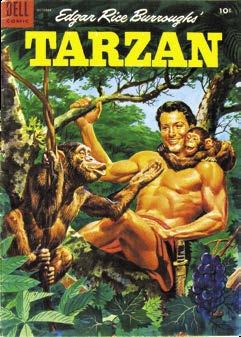
Mary: No.
CBC: He just told me a story the other day of, when he was… He worked as what they called the “Woodchucks of DC,” which were basically the interns. [off-topic anecdote Mary doesn’t really respond to]
Mary: I wasn’t aware of the whole fan world or who the people were, and who I should be impressed with, and who I should be afraid of, or any of that stuff. It was just, these are people, and I’m working for them… ”Don’t give me any crap! Give me my check!”
[laughter]
CBC: That was certainly an asset, right?
Mary: Yes. I told you, I think being oblivious to the misogyny, being oblivious to the double-standard probably was a benefit at the time.
I just thought, [laughs] “This guy’s not going to have an easy sell!”
CBC: So you grew up pretty much as a tomboy?
Mary: Yeah, I like physical things. I was a physical kid. I’m 5' 5", but when I was in the sixth grade, I was, like, the second-tallest person in the class. And I was pretty strong, and I liked being in my dad’s shop when he was in there. I liked mechanical things, I liked knowing how things worked, and I really wasn’t… Back in the ’50s and ’60s, it was like, the whole dream was to get a new appliance or something, if you were female, and I was like, “Come on! I need a drill!” [laughs]
CBC: Were you adventurous, too?
Mary: Well, I was adventurous in that we lived… It was so open around here. It was all desert from the Sahara east to the Maryland Parkway. They didn’t build that up until much later. So I had a whole desert to go play in, and neighborhood kids, and we built forts and we played football. I’d walk on fences and climb trees and hide up in the branches and watch people when they went by.
I had kind of a… my parents just seemed to feel that I should be working all the time. For some reason they felt that I should be doing something productive every minute, and all I really wanted to do was run around and do physical things or read.
CBC: You said there was testing that took place in the area?
Mary: Yeah, the “Test Site”. When was a little kid… I’m the same age as [Steve] Gerber, so I was born in ’47. When I was three and four, they would set off bombs out at the Test Site, nuclear tests, and they would rattle the house. They’d go off about five or six in the morning, and nobody really thought anything of it. That was just what was going on out there.
Nobody knew that they had people exposed, standing up to see what would happen when they did above ground tests. We didn’t find that out until later. And then, of course, it all blew into Utah and Arizona, so we didn’t have a lot of local consequences.
CBC: [Laughs] So the Mormons got it.
Mary: Yeah, really. It’s not funny. [laughs] They did get…
CBC: But Sin City didn’t get it.
Mary: Yeah. [laughs]
CBC: Was it called Sin City at the time?

Mary: No. It wasn’t called Sin City. It was the Strip and it was Las Vegas and it was Vegas
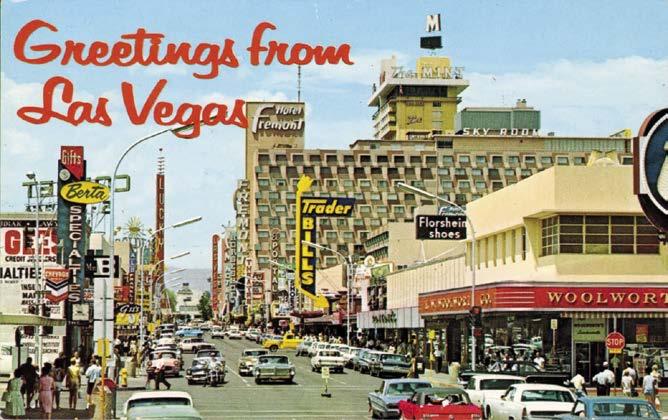
CBC: Was it an “up all night” kind of town? Did you have any indication of that?
Mary: Well, it was always a 24-hour town, which makes it difficult to live anywhere else when you’ve grown up here. You can get anything here whenever you want it. Some grocery stores were open, and you could buy liquor, and you could probably get your hair done or a manicure. You could buy clothes, go to bars all night long, or get your car washed. I mean, anything was possible here 24 hours a day. And so, when I would go other places… I mean, when I moved to New York, and the bars closed at four o’clock, I couldn’t believe it! [laughs]
CBC: “What’s up with that?” [laughs]
Mary: “What was that? We’re just getting started, here!”
48 #33 • Winter 2024 • COMIC BOOK CREATOR
Tarzan TM & © Edgar Rice Burroughs, Inc. Uncle Scrooge TM & © Disney Enterprises, Inc.
CBC: Sexuality. [laughs]
Mary: And she did a good job with those books. She turned them around in a year. And I don’t know…
CBC: Then Joe Simon got them, and they went right in the toilet. [laughs]
Mary: Really. She did a lot of things with those books and really turned them around. But nobody could understand what she was doing, later. They didn’t get it. They didn’t see the fashion thing. They didn’t see what the colors were on the cover of Cosmo, or Seventeen, or however she… It was all psychedelic back then, when she took them over. She used psychedelic colors and she made the clothing contemporary. I think Dick Giordano designed eyelashes for women in romance comics that never changed. I mean, those huge… [laughter]
CBC: He was doing those at Charlton. [laughs]
with sales and he reneged.
CBC: Dick had the most exciting books, I thought, as a kid growing up. And then finding out the real story from him, while sitting at a kitchen table across from Dick in his home, about how he was treated… “Wow, man, that sucked!”
Mary: I know. He really did have creative control issues with Carmine. I’ve heard “the powers that be,” but it was Carmine. Carmine didn’t like what Dick was doing with the new talent, he didn’t like the area that he was going into with the writing and the art. I don’t know, I think Carmine was a little bit… He didn’t screw much with Neal [Adams]. For some reason, Neal had an office and a drawing board at DC. It was like… And Neal had a beard, and I don’t know, he just kind of [chaffed] with Neal. And [Neal] was always late. [laughs]
CBC: There’s a lot of passive/ aggressive sh*t that went on between him and Neal. And Neal was eventually… I don’t know, forced out or… He certainly made his own way with Continuity… Mary: Yeah, he and Dick started Continuity Associates and they had the Crusty Bunkers. So anyway, they had a good career over there, and they had a lot of advertising work because of Dick. And then Neal had the last laugh, because he and Jenette Kahn got together after Carmine was out. [laughs]… Neal was macho. He had his own agenda. It’s not that Neal was… I mean, Neal helped a lot of people, but he also liked to be in control and that was kind of irritating. The guy was talented, definitely talented. He put the balls on Superman and Batman. [laughs]
Mary: He created those at Charlton and that was it from then on. [laughs]
CBC: And Johnny Romita started doing it, too. [laughs]
Mary: Yeah. [laughs]
CBC: So was it that perhaps Dorothy was bringing a real-world publishing mentality to the problem, of really trying to be contemporary?
Mary: Yes. She was trying to make the books contemporary, and she knew there was a market. Knew that her books could sell, and they did. But what was your question about that? I mean, that’s the reason that nobody could follow her, because some guy couldn’t take over the romance books and keep them selling…? [laughs]
CBC: Well, I think certainly there’s a perception… Not enough people think about it, really, I think, but that Dorothy was really trying to do something there. She was hitting roadblocks all the time… [DC publisher] Carmine [Infantino] was just such an asshole to certain editors whom he was just crushing for the sake of crushing them, because he didn’t like them.
Mary: Well, he was. He had a bet with Dorothy. She beat him
CBC: That’s exactly what I was going to bring up, as far as emasculated men. Do you think, in a sense, that comic books, the industry itself was just too populated with mousy guys, guys who wouldn’t… I mean, obviously, artists are sensitive. Writers are sensitive.
Mary: Sure. And it seems to me there were a lot of artists… I’m trying to think who else. Julie Schwartz wasn’t emasculating, he was just kind of “Julie.” I didn’t ever meet Mort Weisinger, he was gone. Joe Orlando was… Is he still alive?
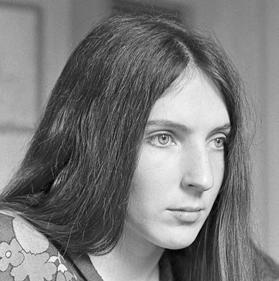
CBC: No.
Mary: Okay. Joe Orlando felt emasculated and bitter about it. [laughs]
CBC: That was a nasty divorce.
Mary: Which one? [Jon laughs] If I had a story where
This page: Clockwise from below, Skrenes uses her “Kevin Frost” penname for her Journey into Mystery #5 [June 1973] story drawn by Win Mortimer; Skrenes provided the plot for the Sinister House of Secret Love #1 [Nov. ’71] lead story; Wimmen’s Comix #6 [Dec. ’75] tale by Skrenes and Michele Brand; and Brand in photo by Clay Geerdes.
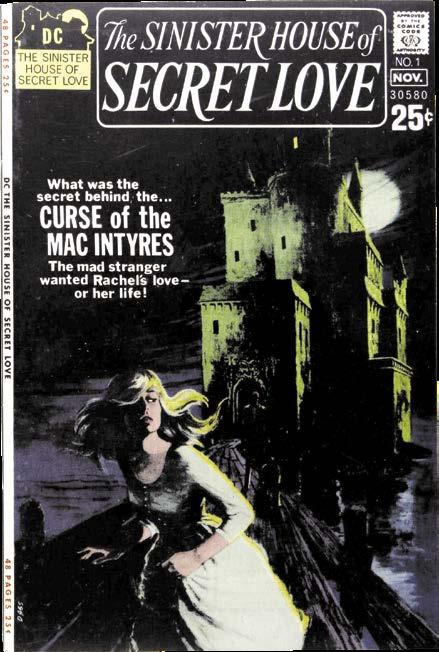

55
COMIC BOOK CREATOR • Winter 2024 • #33
The Sinister House of Secret Love TM & © DC Comics. “Victoria the Woodhull” TM & © Mary Skrenes and the estate of Michele Wrightson. “For Love of Money” © Marvel Characters, Inc. Brand photo © the estate of Clay Geerdes. Used with permission. Courtesy of David Miller.
CBC: Have you always maintained this friendship with Steve Gerber?

Mary: Oh, yeah. His oldest friend died recently, and he told me now I’m his oldest friend. I think the world of the guy, and we’re good friends, and I really enjoy his company. And I’m collaborating with him again, just for the hell of it, just because I enjoy it.
CBC: Are you?
Mary: Oh, yes.
CBC: Oh great! What is it?
Mary: It’s Hard Time, the book that he’s doing for DC. And I get to do violence and come up with gimmicks, come up with violent gimmicks. [laughter] It’s a release.
CBC: The first time you really came into recognition for me as a kid was what I thought was just an absolutely delightful book. I really loved Omega the Unknown. I loved Howard the Duck, but there was something real about Omega the Unknown, oddly enough. What was it like working on that book?
Mary: I really enjoyed working on that book, because we
moved James Michael from the laboratory he lived in, on an idyllic mountain somewhere, into Hell’s Kitchen. He had two women, totally different types, that he lived with and the school. I often call Ethan from Hard Times “James Michael,” just because they’re both little kids with dark hair. I loved that book. Jim Shooter screwed it up. It didn’t have anything to do with Archie Goodwin. We were supposed to have complete creative control on Omega. Then Jim Shooter came in. He pissed me off, and I pissed him off. From then on it was like…
CBC: What pissed you off?
Mary: We were supposed to have creative control over that title. We wanted to do a cover that had James Michael standing defensively over the unconscious form of Omega. Jim Shooter calls to say… I didn’t know him, had never talked to him, but, instantly I didn’t like his attitude. I mean, he looked like Bernie’s Frankenstein, I could have liked him. [laughter] But he was already sticking his nose in and he calls to say, “You can’t have that cover. We can’t have the super-hero be the one on the ground,” and na-na-na. I’m trying to tell him, “But we have creative control. Stan said we could do whatever we want with this book. And there’s a reason for this cover…” He was really infuriated. “No, you can’t do it!” I said, “Well, go ahead, then, just f*ck up the book!” And hung up on him. [laughs] So you can imagine how well that went over with him. I just told Steve about it a couple of months ago, he said he never knew this. He only knew that the book was taken away from us for a couple of issues, by Shooter.
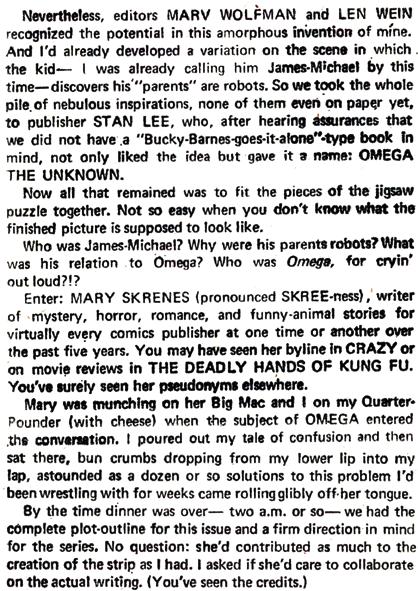

CBC: And they… f*cked up the book. [chuckles]
Mary: I still run into people who want to know. That was the first book that I got involved with the fan mail. We would get letters from kids who couldn’t wait for James Michael to beat the sh*t out of those bullies at school because, every day, they had their lunch money stolen, or somebody would beat up on them, or trip them, or give them a wedgie. We had all these kids writing in, saying they were identifying with James Michael, and just couldn’t wait for the day when he fought back. And, of course, that wasn’t our plan. He was shocked the
#33 • Winter 2024 • COMIC BOOK CREATOR 64 [laughs]
Inset right: Steve Gerber’s text page in Omega the Unknown #1 [Mar. 1976], discussing his writing partner and then-paramour, Mary Skrenes. Below: Credits from the splash page of Omega #1.
& ©
Below: Cover of Omega #1, with art by Ed Hannigan and Joe Sinnott. Name originated by Stan Lee.
Omega the Unknown TM
Marvel Characters, Inc.
The Duck’s Other Dad
Val Mayerik on Comics and Co-Creating Howard the Duck
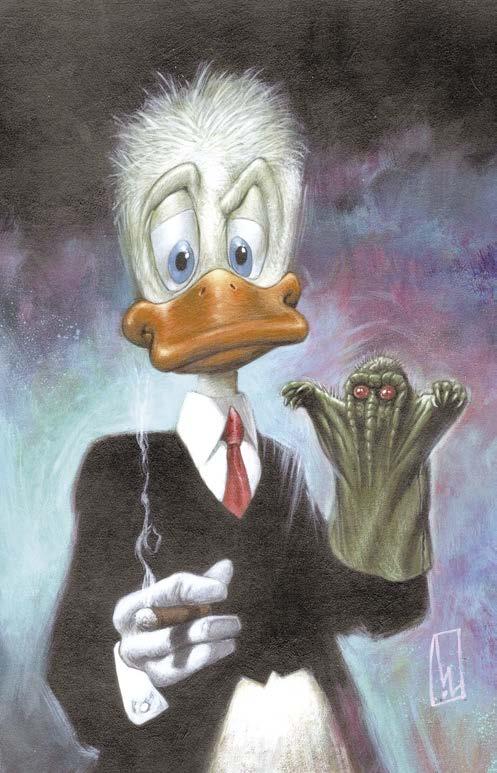
Maybe it comes as no surprise that Val Stephan Mayerik, who grew up with a working-class upbringing in his native Youngstown, Ohio, raised by an insurance salesman dad and automotive factory worker mom, was drawn to comics in part because of a talking duck story. It was a Carl Barks’ saga published when he was about five years old that made an impact, “The Lemming with the Locket,” in Uncle Scrooge #9 [July 1955]. “What I think impressed me the most was the fact that the artist… drew every damn lemming! They just drew these thousands and thousands of lemmings… it could have been a full or half-page splash… [and] to see a huge panel that size, I remember that being impressive to me at the time.”

Despite a fate that would likely lead to working the assembly line at the General Motors plant on the outskirts of town or toiling in the region’s steel mills, Mayerik, along with a motivated sister who would design theater sets and work as fashion designer, was driven to be creative. And he liked comics well enough: “ It was a cheap source of available entertainment. I think I might have had more of an affinity for them because I liked drawing and I always — I don’t think I ever actually foresaw myself doing comic books, but I always thought someday I would be drawing something, and I liked telling stories with pictures, so I think that that drew me a little closer.”
Supported by a mother who signed him up for art classes, though his father hoped he’d end up getting a college engineering degree, the youngster, “I just drew all the time, and kept drawing all through high school.” And engineering? “I just had no affinity for that sort of thing.” But, along with drawing, the stage grabbed Mayerik’s interest, though with the Vietnam War then raging, the military draft was a concern.
“Towards my junior and senior years of high school,” he shared, “I was considering going to England to try to study drama there. But I had no idea how that would affect my draft status, and it worried me. I wasn’t sure really what to do.” That indecisiveness would persist for Mayerik, who would be rejected for service because of a minor thyroid condition, and attending college for a four-year stint (but “nowhere near graduating”) before dropping out. But even after developing a passion for martial arts, Mayerik had little direction.
“For the most part, I was living in a little town called Warren, Ohio,” he explained, “and I had a little, tiny apartment I was sharing with somebody over there. It was a really depressing little town. It still is. There is no culture there. There’s nothing going on. And I was visual, and I liked acting, so obviously I gravitated to two things: the movie theaters and the comic book stands. And then the sci-fi paperback racks, to see if there was a new Frazetta or a Jeff Jones painting that was on a book cover. So that stuff, I just absorbed it like a sponge, because there was nothing else.”
By chance, something else did arrive in Mayerik’s life when, in painting class, a
woman overheard him talking with a classmate. “She said she lived in a little town called East Liverpool, Ohio, and there was a guy that lived there named Dan Adkins, who was an inker. And I said, ‘Oh my God.’ I couldn’t believe it. I kept thinking that you had to go to New York City to meet all these people, because the way Stan wrote the Bullpen, it made it sound like everybody’s in the same office in Madison Avenue!”
by Jon B. Cooke

Mayerik said, after meeting with Adkins and showing his work, “I just moved down there. It was about 50 miles away from Youngstown. I moved down there and just hung out with Dan for, like, six months. He just showed me little things I needed to know, like how to lay out a page so it makes more sense, how to ink with a cleaner style, how to pay more attention to” backgrounds and perspective. “And he’d kind of shake me up a little bit, and let me help him ink a few things. And then suddenly Roy Thomas sent me some scripts, and that was it.”
The first job was a Brak the Barbarian tale [Chamber of Chills #1, Jan. 1973] He said, “It was my first story, I was very, very thrilled. [Adkins studio mate P.] Craig [Russell] got his first story at the same time, so we got to watch each other’s progress on the story.”
Very soon, Mayerik found a regular assignment, penciling the Man-Thing series in Fear, starting with #13 [Apr. 1973], which, along with his other Marvel jobs, left him ambivalent because of the atrocious inking his penciled pages would receive. “I was very discouraged early on. My first couple of years in comics, I was able to ink the black-&-white Frankenstein stuff [in Monsters Unleashed] myself, I was getting some fairly decent inkers on the [Living] Mummy book, and then things just started going to hell. And Vince Colletta inked a whole lot of my stuff, and really, really bad inkers inked my stuff. I couldn’t seem to make any headway with [then Marvel editor-in-chief] Roy Thomas… So whenever I
EDITOR’S NOTE: Much of this article includes quotes from a 2003 interview with Val Mayerik conducted by Ye Ed..
Above: This Mayerik commission piece inspired our cover. Inset left: Mayerik posing for fellow artists in the ’70s. Below: It was a 1955 Uncle Scrooge story that helped foster an interest in comic books for young Val Mayerik.
73 C OMIC BOOK CREATOR • Winter 2024 • #33
Howard the Duck, Man-Thing TM & © Marvel Characters, Inc. Uncle Scrooge TM & © Disney Enterprises, Inc.
Above: In 2016, Val Mayerik acted an indie horror film called Quantum Terror, in which he plays a “detective trying to solve a supernatural crime.” He called his experience working with “some really talented people” to be “great fun.” Below: Two Howard the Duck newspaper comic strips drawn by Mayerik, dated Oct. 17 and 18, 1977, episodes recounting his origin. The artist recalled the assignment was a miserable one.

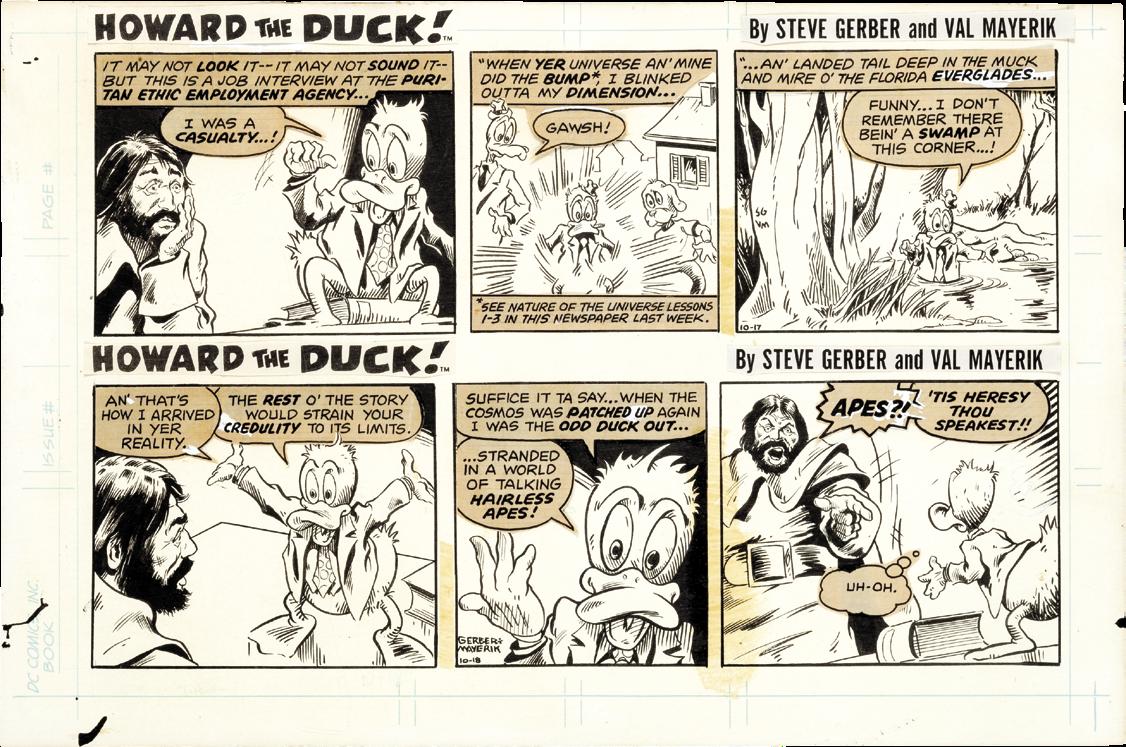
would ask for a better inker, it would just fall on deaf ears.”
About Man-Thing, the artist shared, “That was frustrating as well, because at the same time, Wrightson was doing Swamp Thing, and he got to ink that himself. And the colorist at DC… DC was obviously putting a lot of attention on that book, and they were getting him great colorists, and he had a great writer. Gerber was writing Man-Thing, and Gerber’s a good writer. I like Steve personally, I like his writing. But it’s obvious Marvel just wasn’t… I didn’t think Marvel was exhibiting any real concern for the character, for the book. Like you said, the inking jobs, the way they butchered some of that stuff. I spent all this time trying to make it look real Frazetta-like, with all these great renderings of the Man-Thing and the textures and the reflection
in the water. And then, holy God in Heaven, they just butchered it. Besides the inking being horrible, they threw all these bright colors on it. They made the swamp look like a gymnasium. It was just terrible… They gave me a different inker every issue. The only guy that I was satisfied with, a guy named Chic Stone inked one job. And he wasn’t a great inker, but at least he was the closest to what I had drawn of any of these guys. Another one was Sal Trapani… “
About any collaboration with the writer, Mayerik explained, “Steve pretty much presented a script. I can recall times of Steve being more collaborative, like on [two issues, 1984–85]. But at this particular time, I wasn’t… I didn’t have any particular feelings where I wanted the character to go, I just liked the visuals of the characters and was perfectly willing to draw what Steve had written… I can’t remember all the stories we did now. I think I suggested to Steve we do something about him running into a bunch of people who lived in the middle of the swamp, who were isolated from the rest of civilization. I can recall making that suggestion, I don’t know that we ever did a story with characters like that, I’m not sure. Other than that, I just went along with what Steve [wanted]… I always thought Steve had entertaining ideas.”
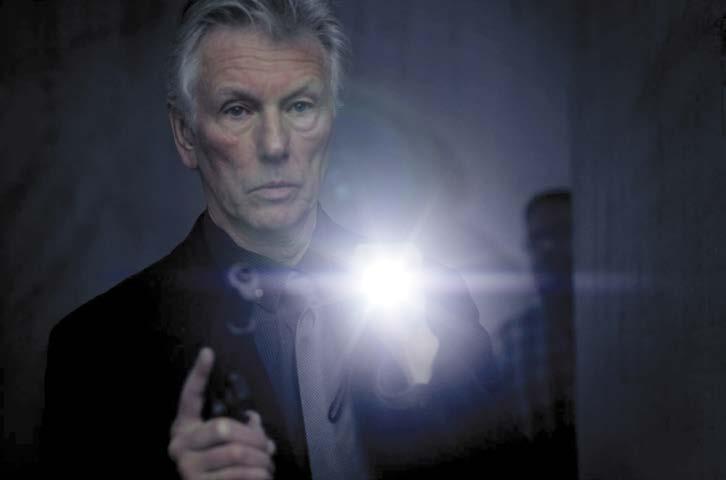
COMIC BOOK CREATOR #33
(84-page FULL-COLOR magazine) $10.95 (Digital Edition) $4.99 https://twomorrows.com/index.php?main_page=product_info&cPath=98_132&products_id=1765
Among those Gerber notions was a certain talking waterfowl that came trotting out of the bushes. Mayerik said, “Well, I have to admit, I have no prescient or precognitive powers about pretty much anything in my life, and I certainly didn’t about comics. I had no idea that duck was going to become popular. Because, in his premiere, there were other weird characters from other weird dimensions that showed up at the same time. So, I thought, if anything, it would all happen as a group, these characters would emerge as a group. But they didn’t.”
#33 • Winter 2024 • COMIC BOOK CREATOR 74
Quantum Terror © the respective copyright holder. Howard the Duck TM & © Marvel Characters, Inc.
IF YOU ENJOYED THIS PREVIEW, CLICK THE LINK TO ORDER THIS ISSUE IN PRINT OR DIGITAL FORMAT!
STEVE GERBER biographical essay and collaborator insights, MARY SKRENES on co-creating Omega the Unknown, helping develop Howard the Duck, VAL MAYERIK cover and interview, ROY THOMAS reveals STAN LEE’s unseen EXCELSIOR! COMICS line, LINDA SUNSHINE (editor of early hardcover super-hero collections), more with MIKE DEODATO, and the concluding segment on FRANK BORTH!









 by JON B. COOKE
by JON B. COOKE










































